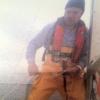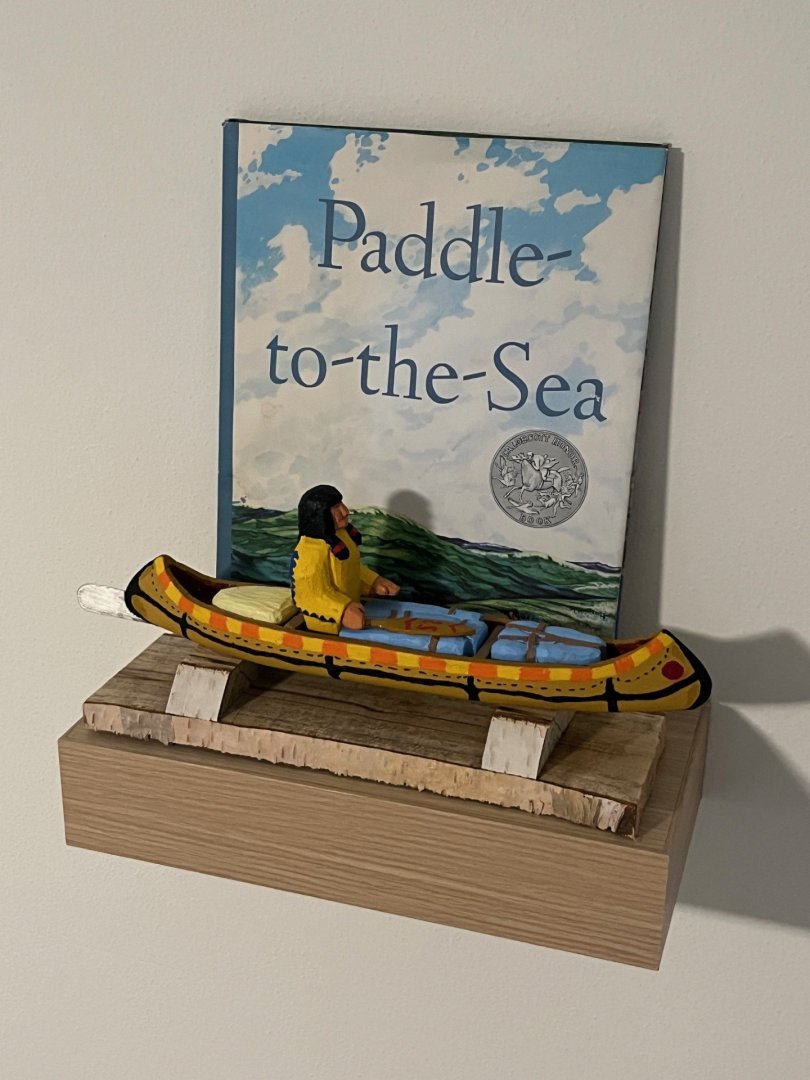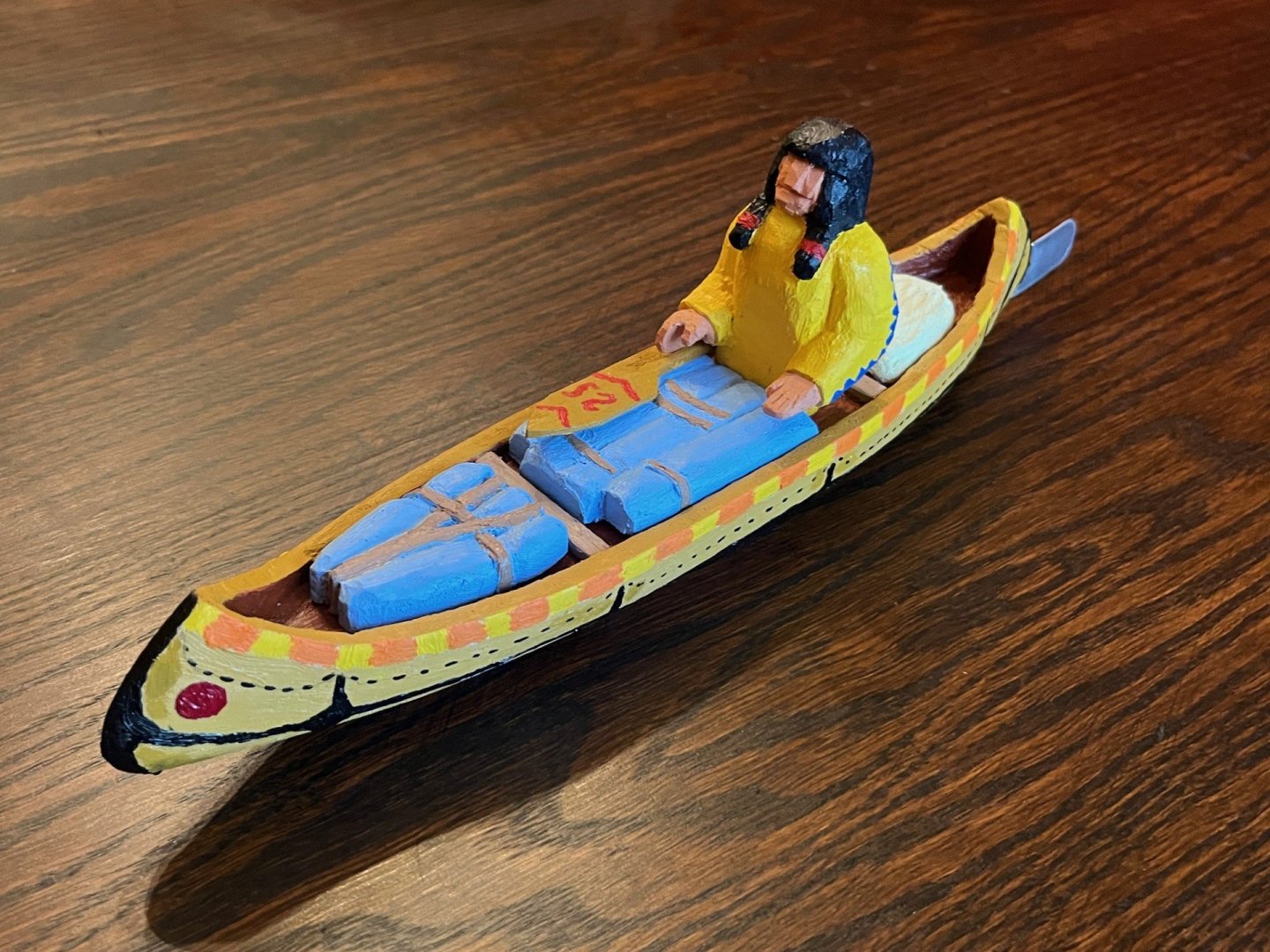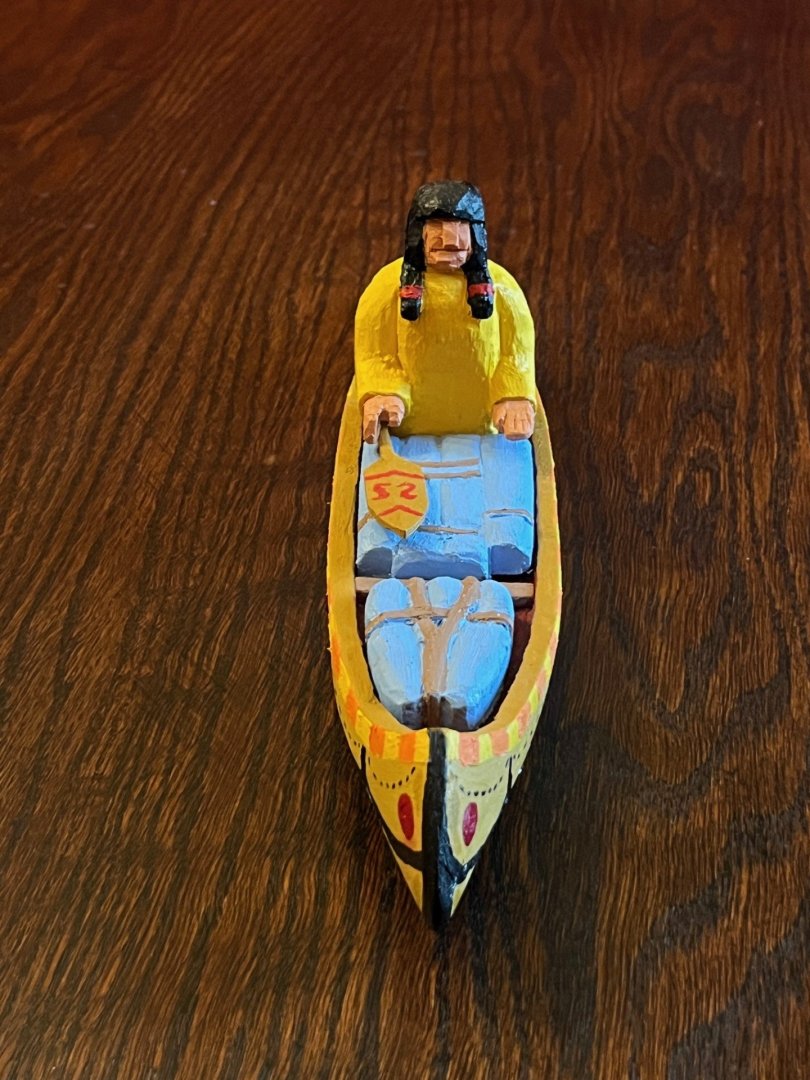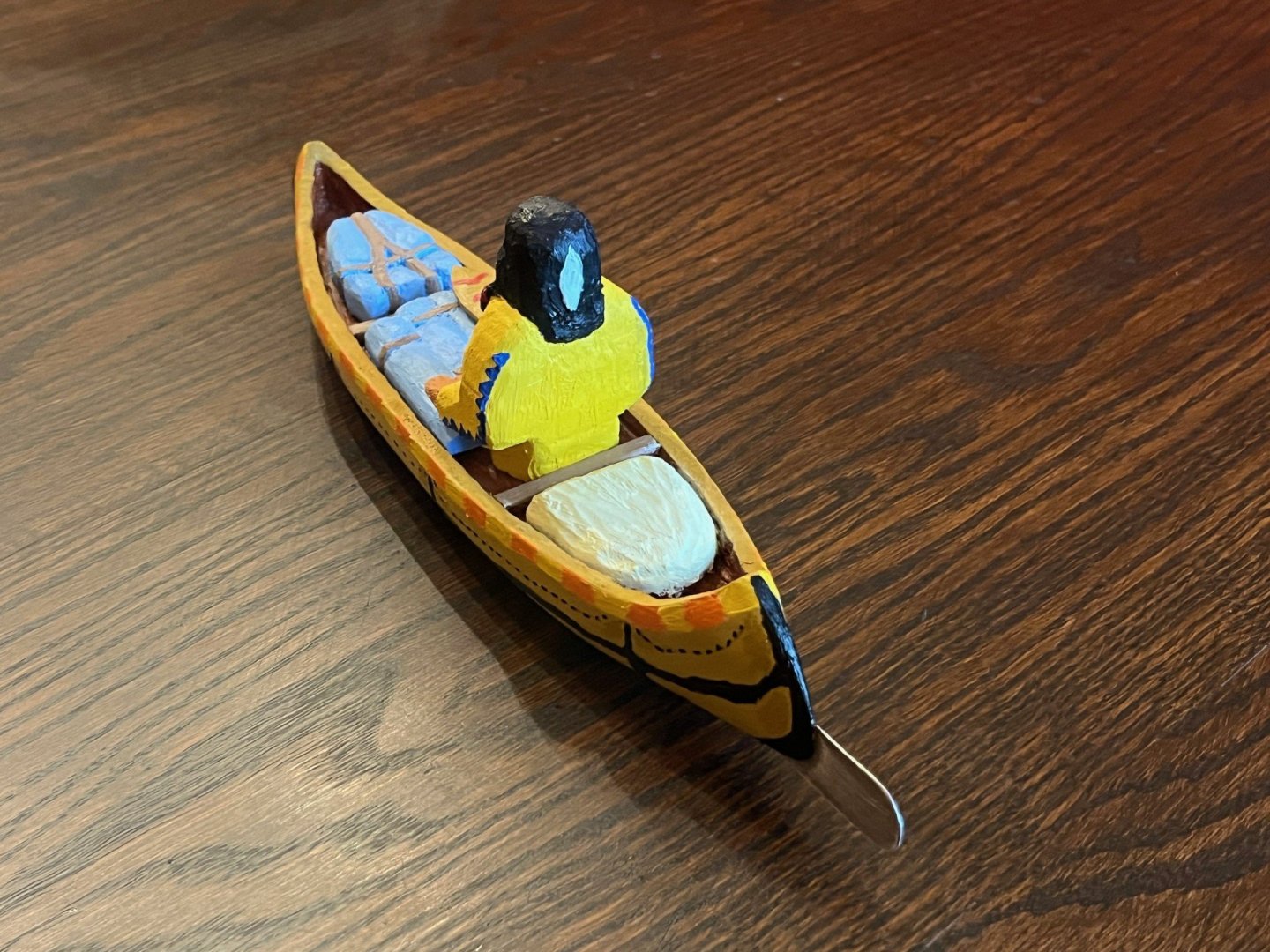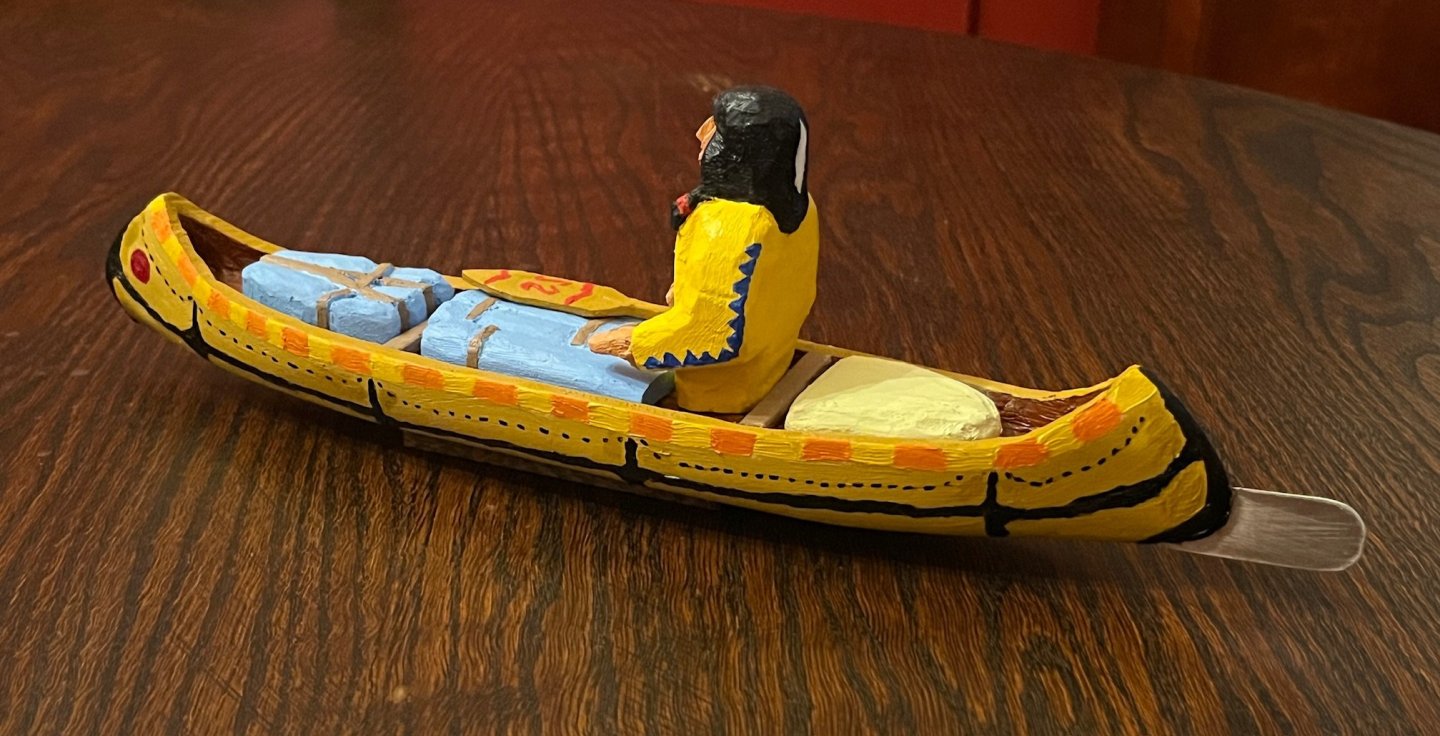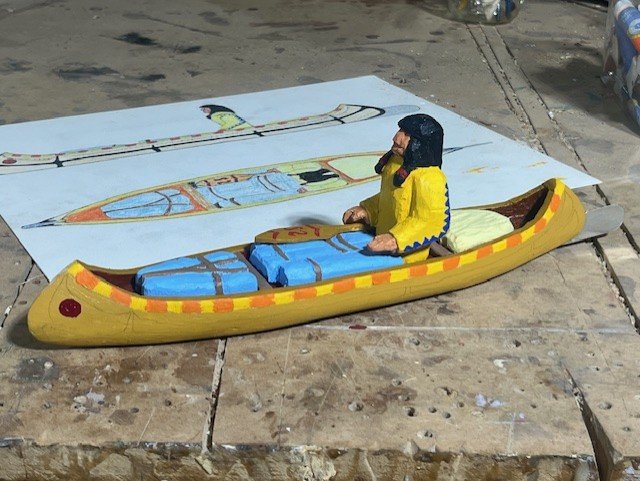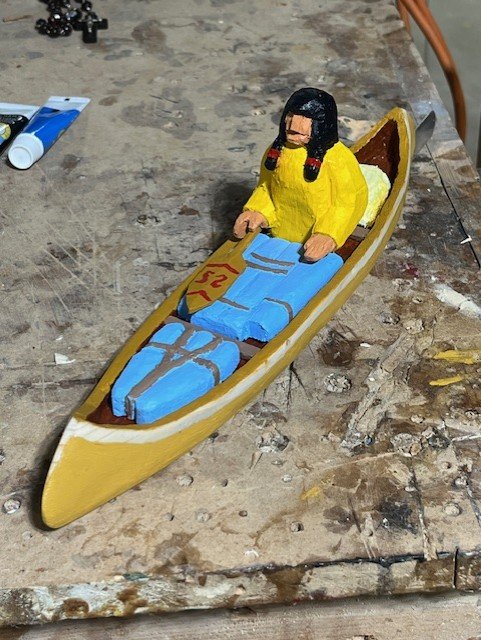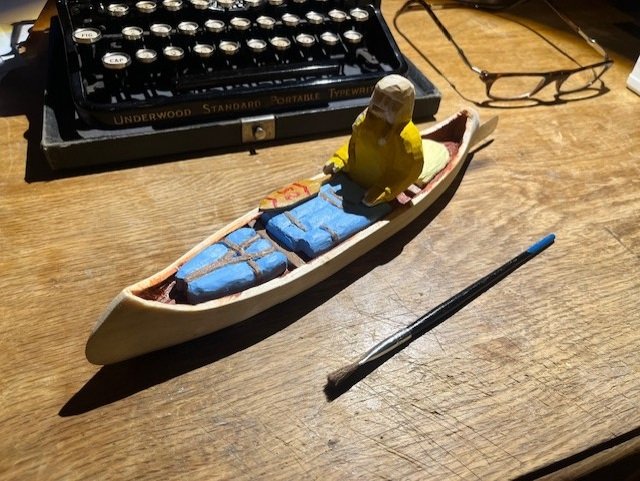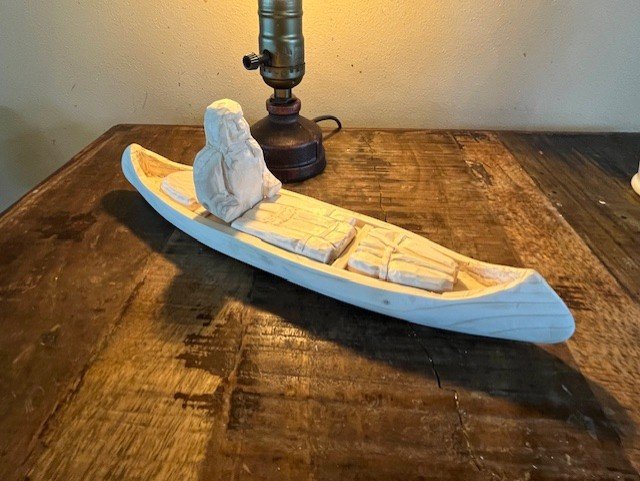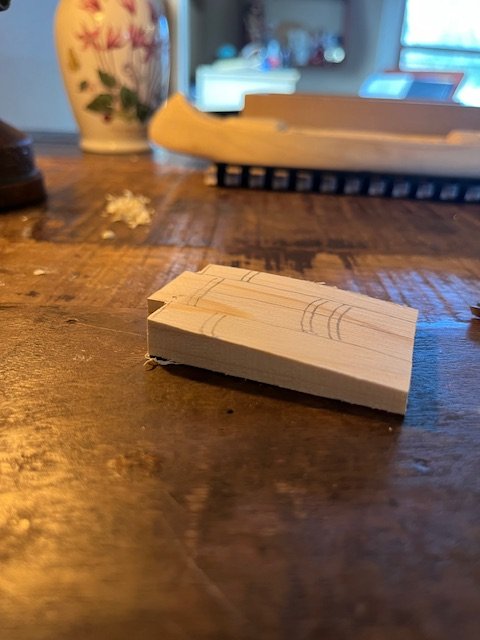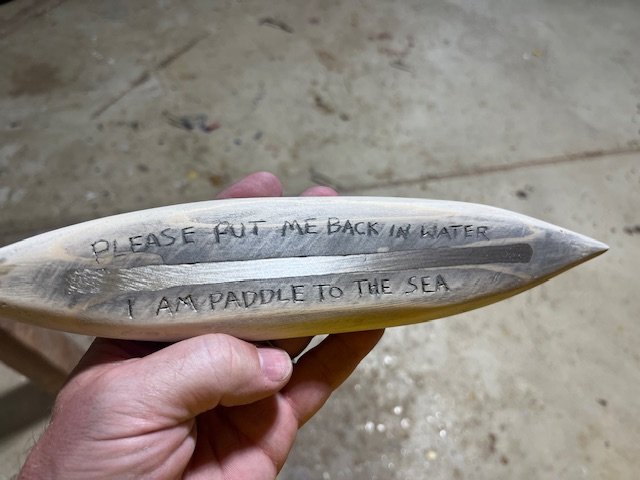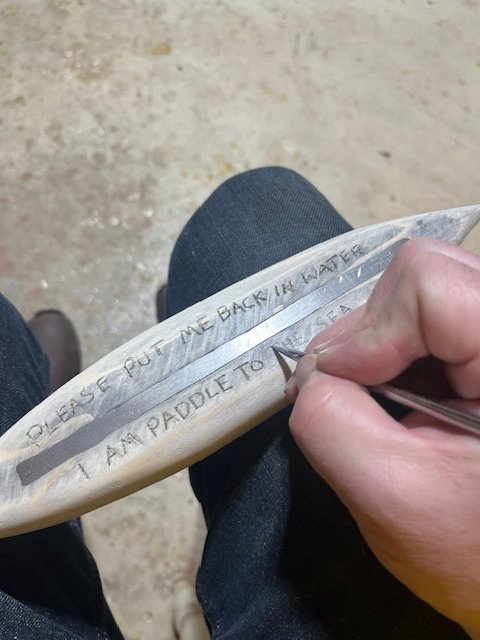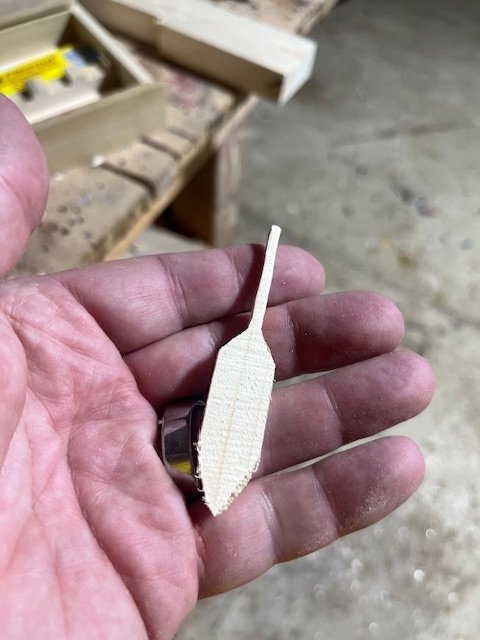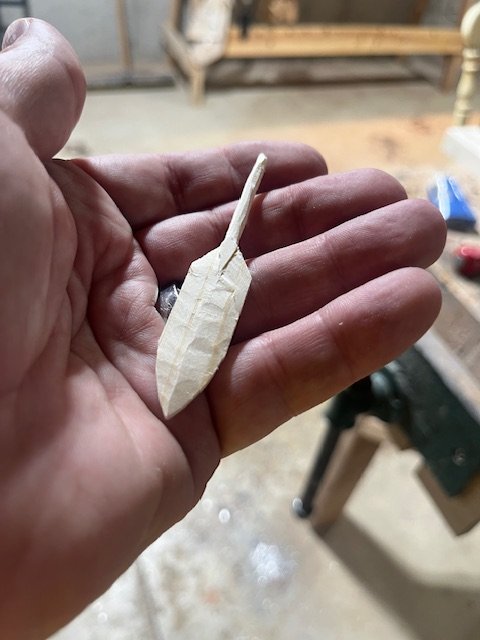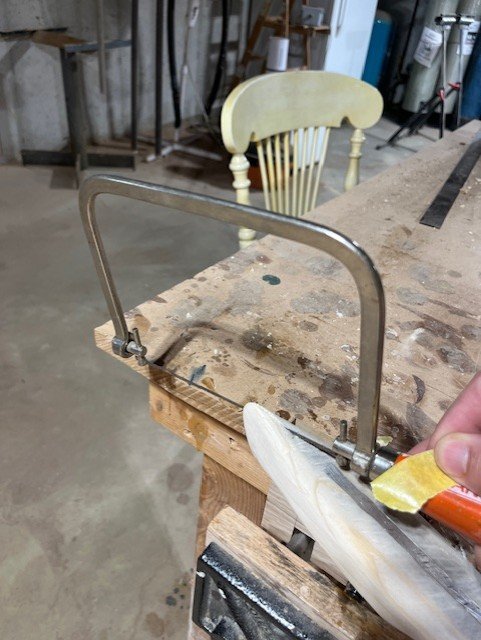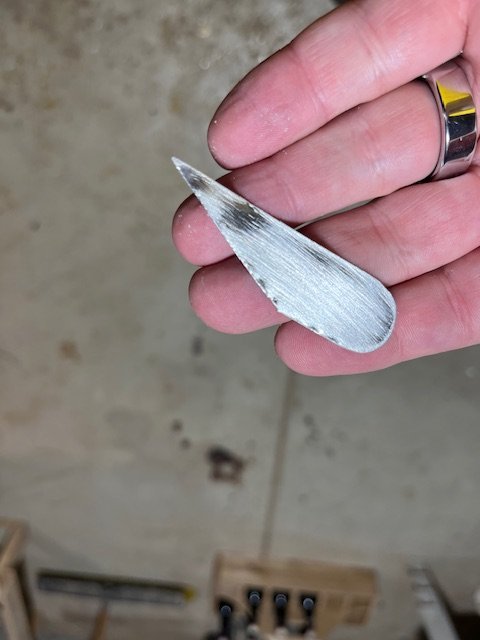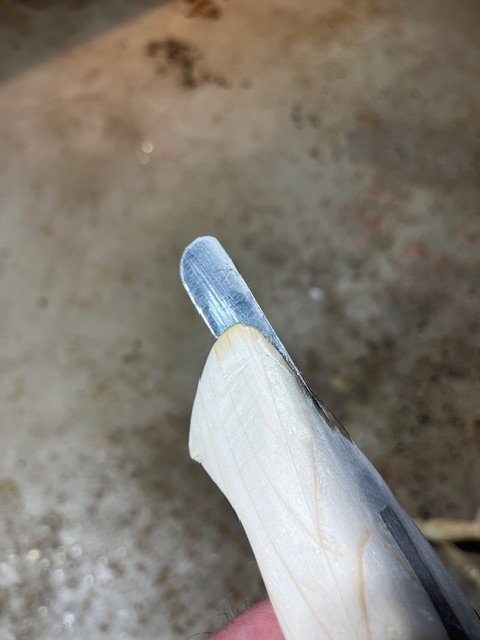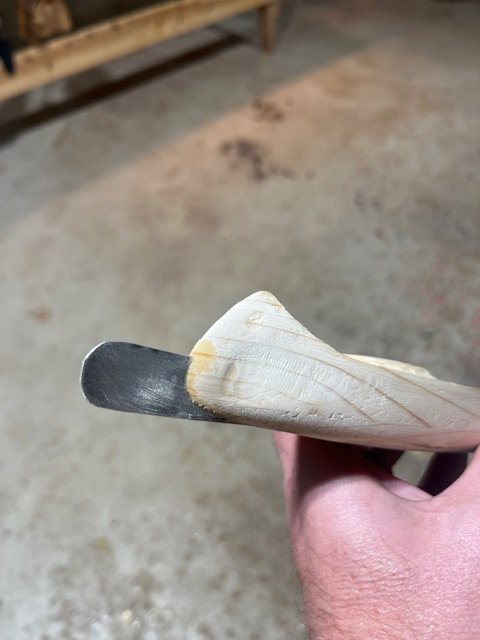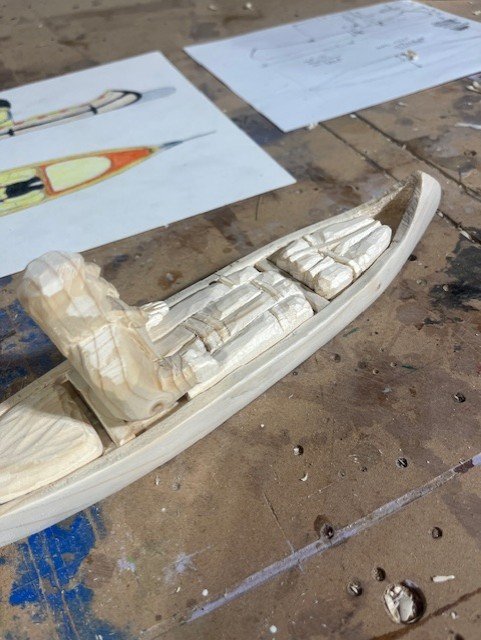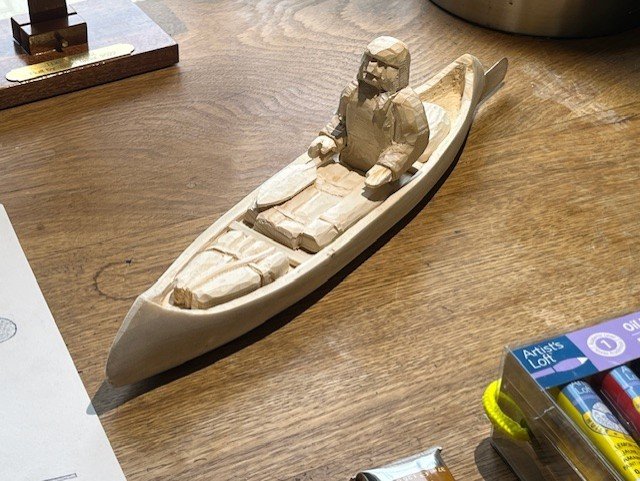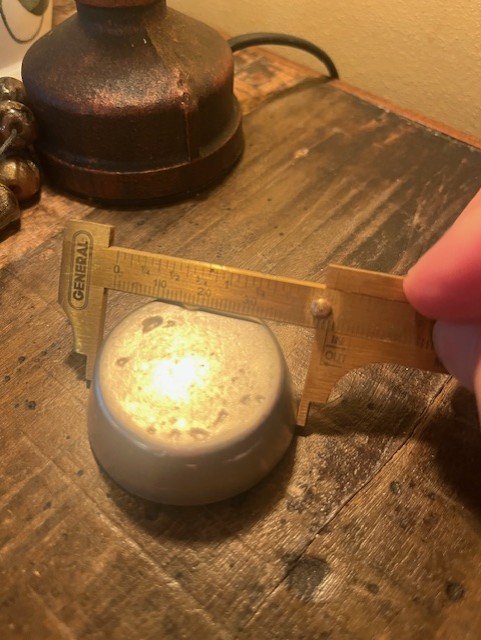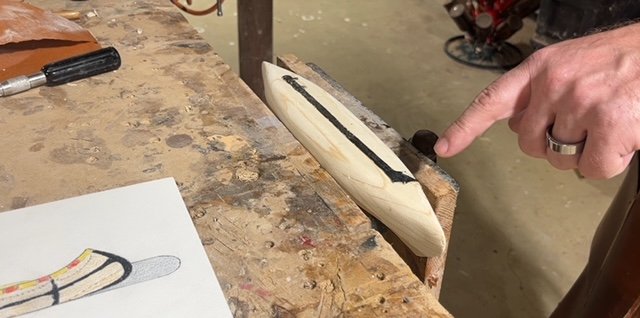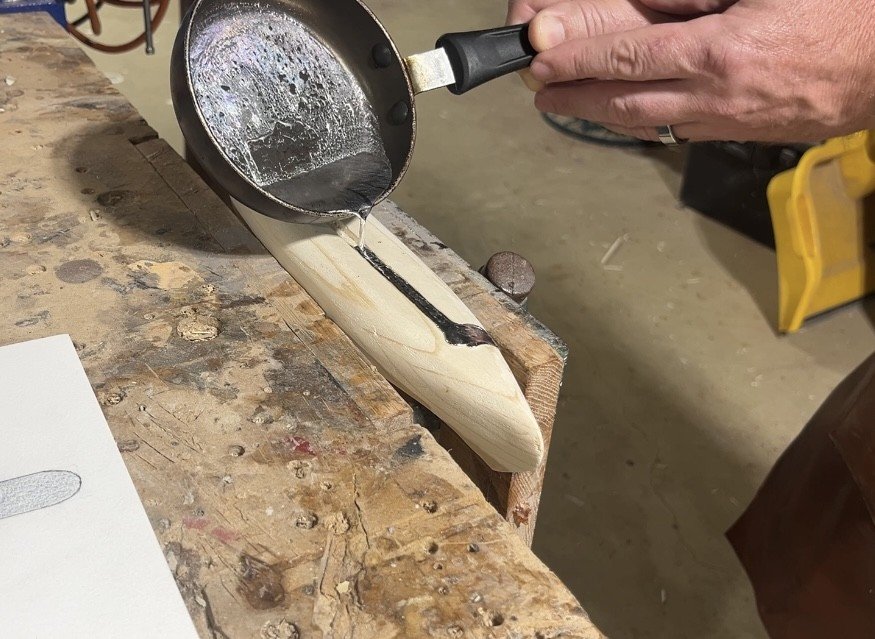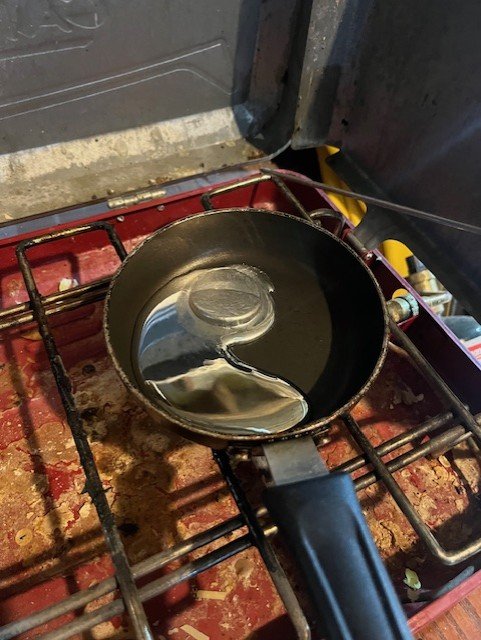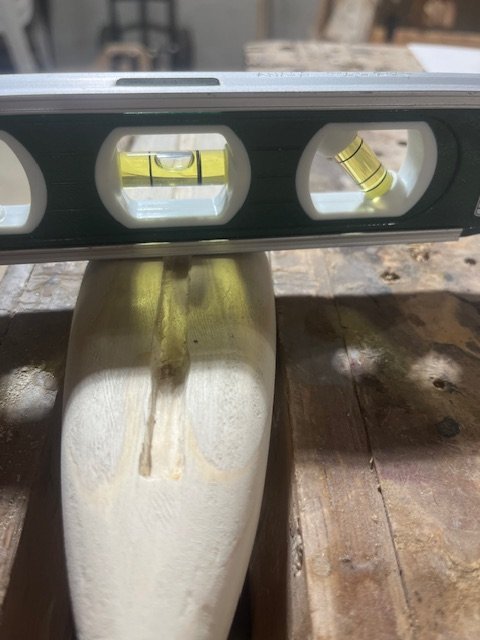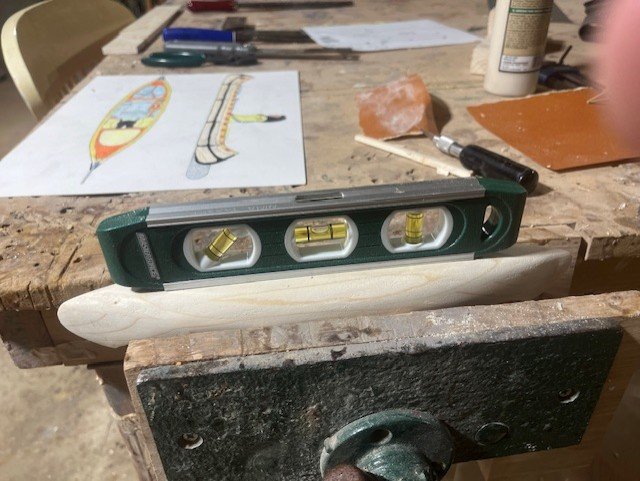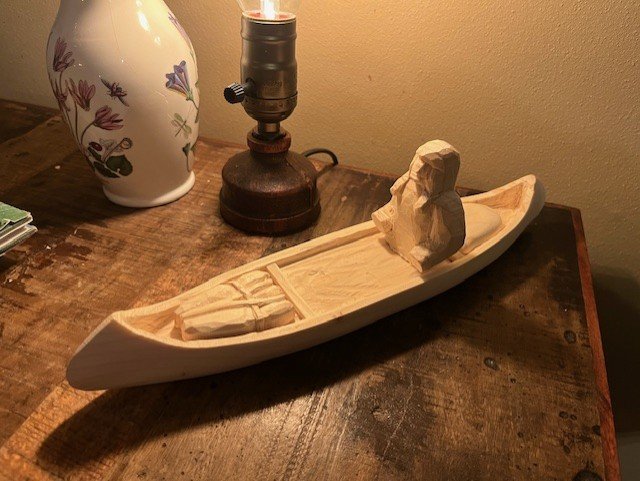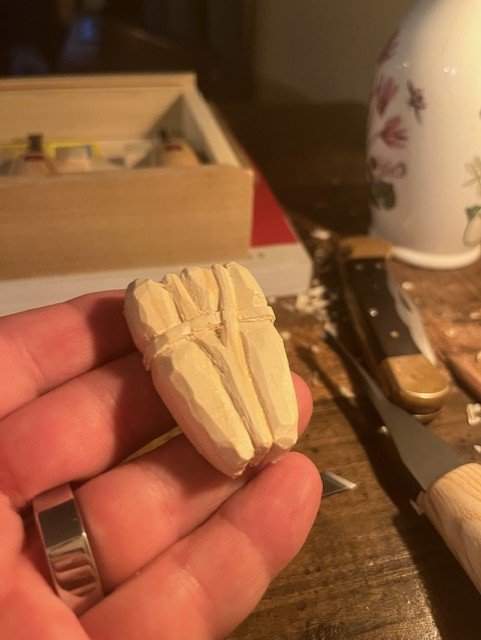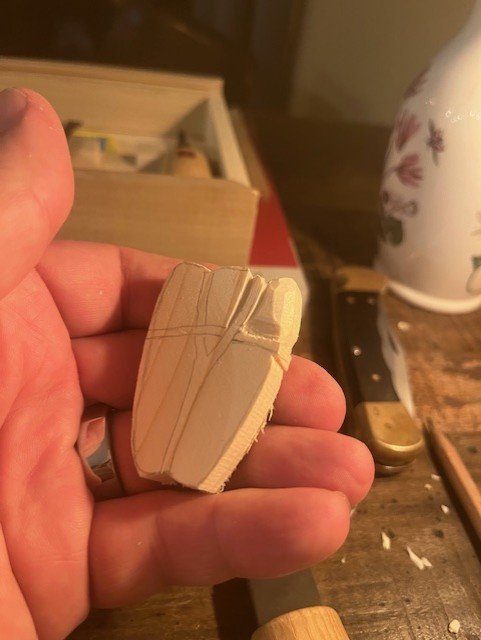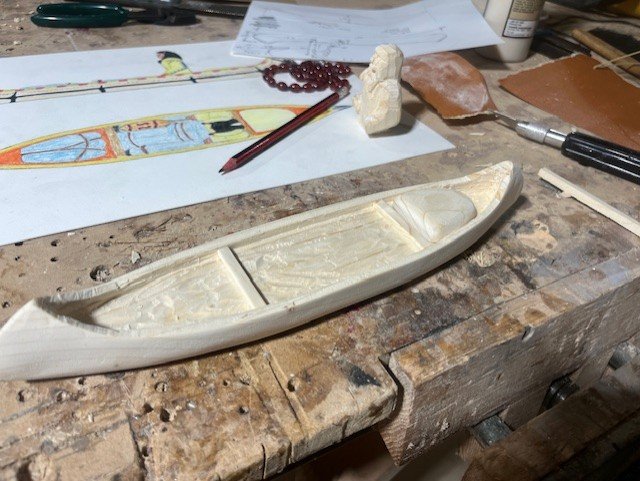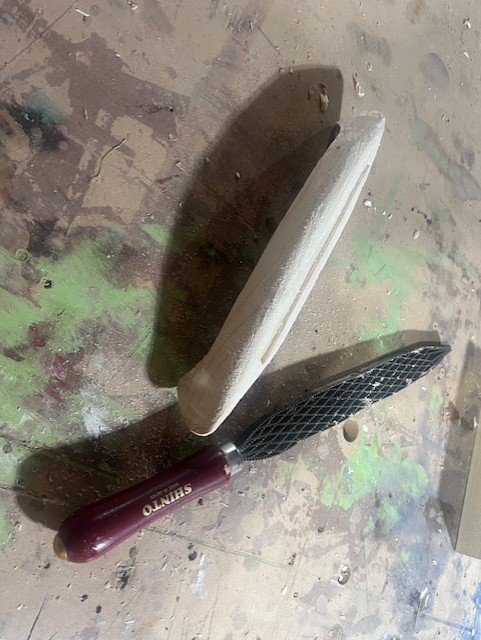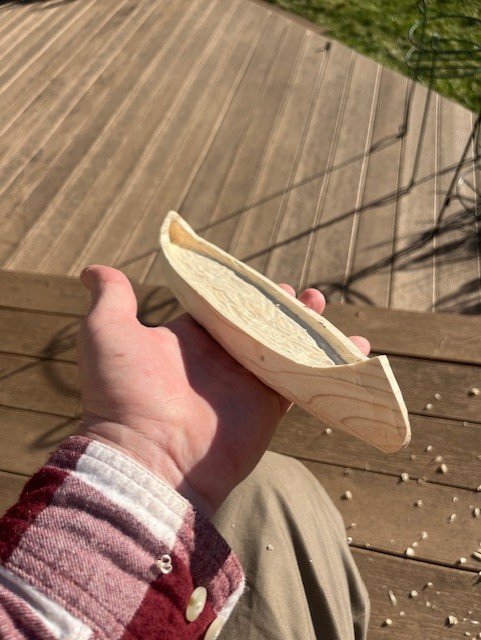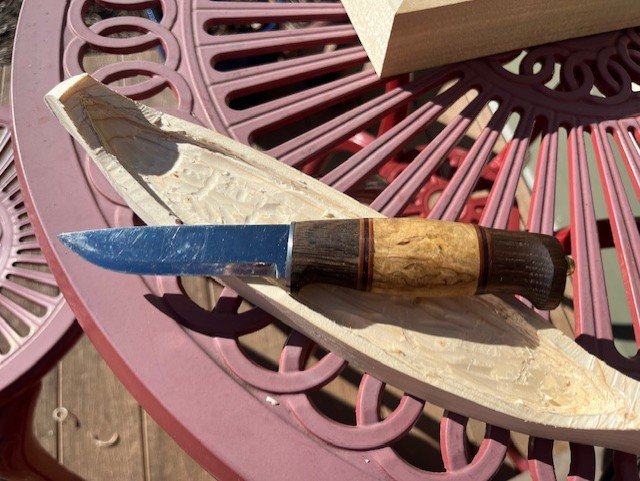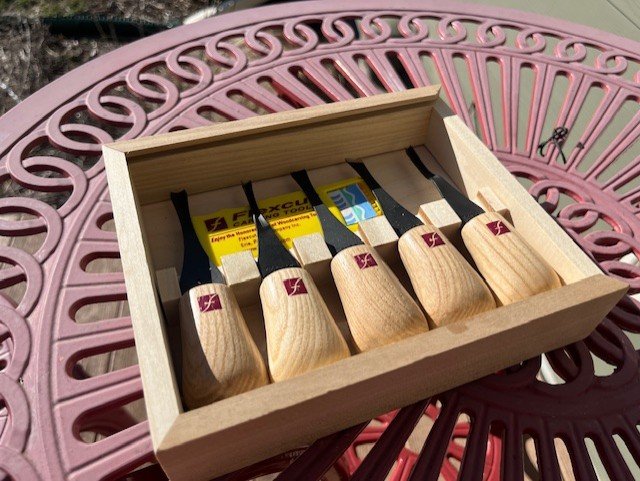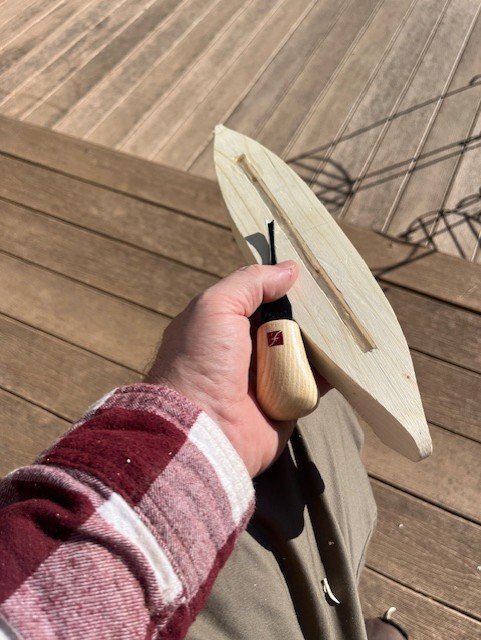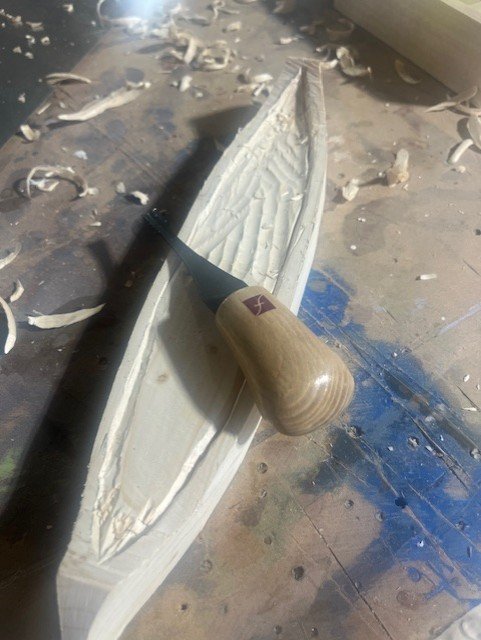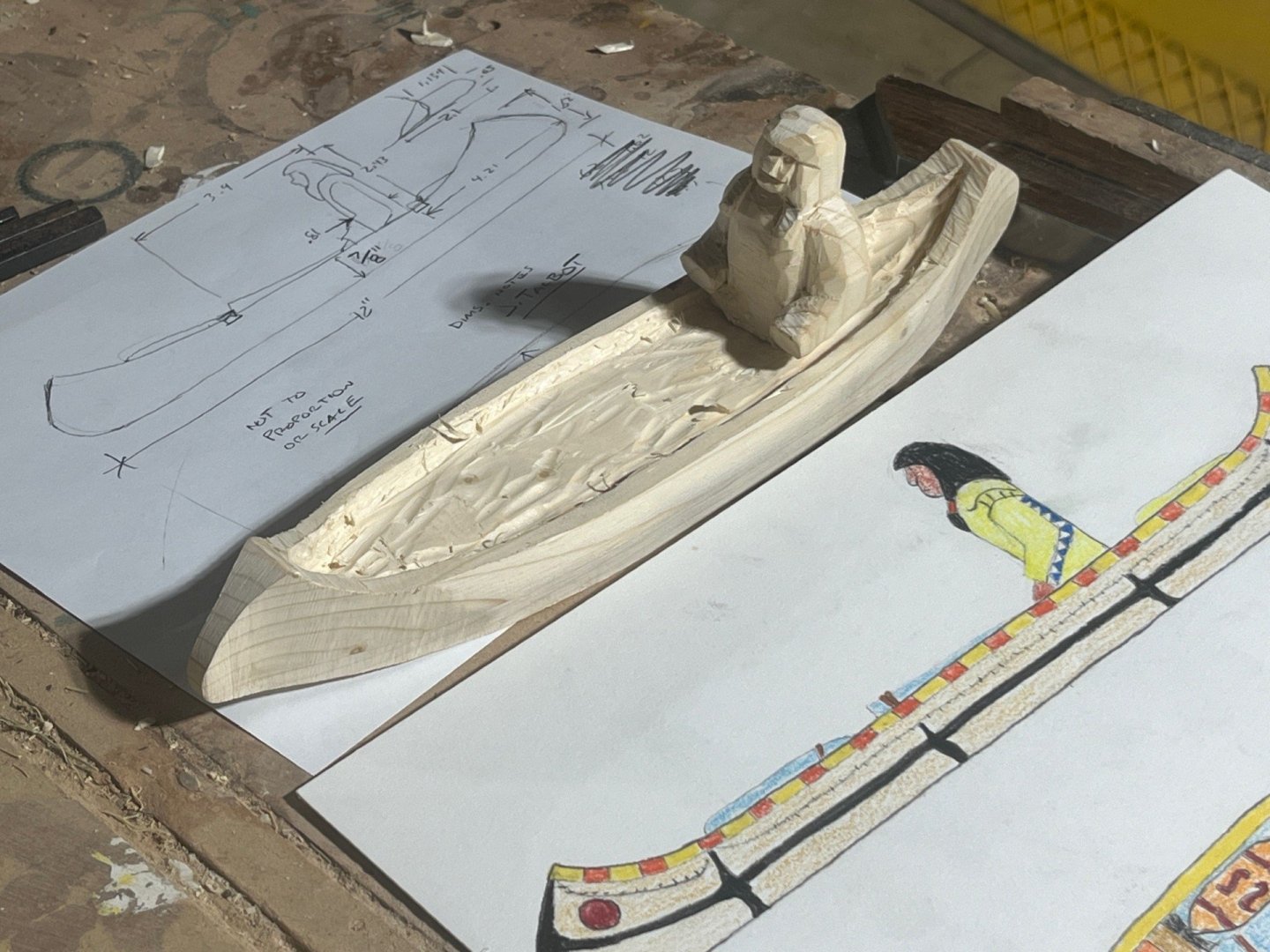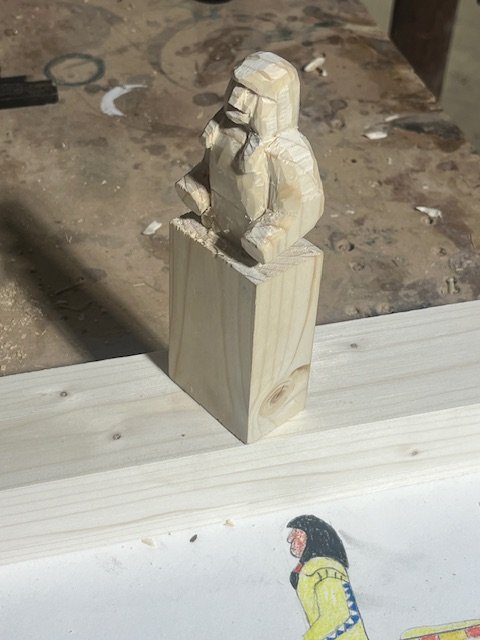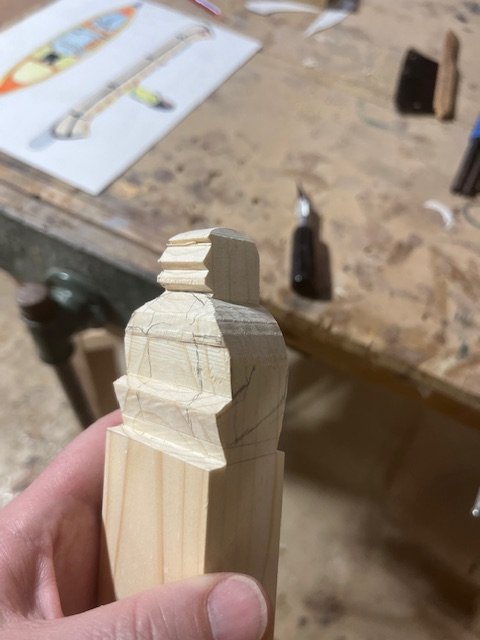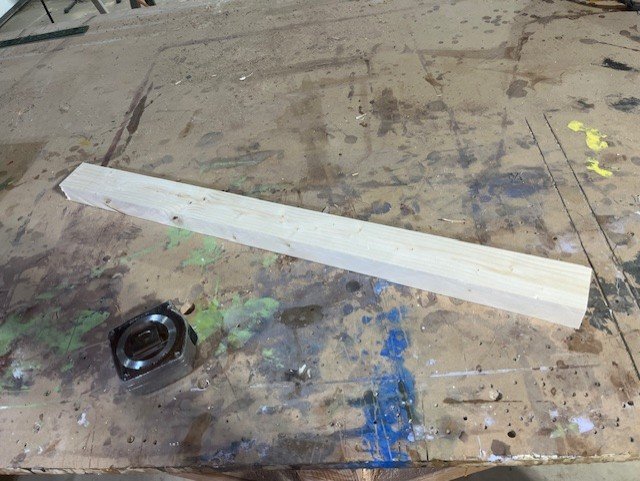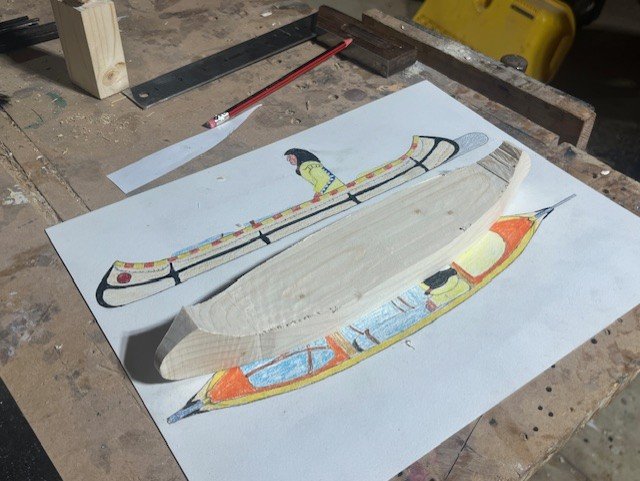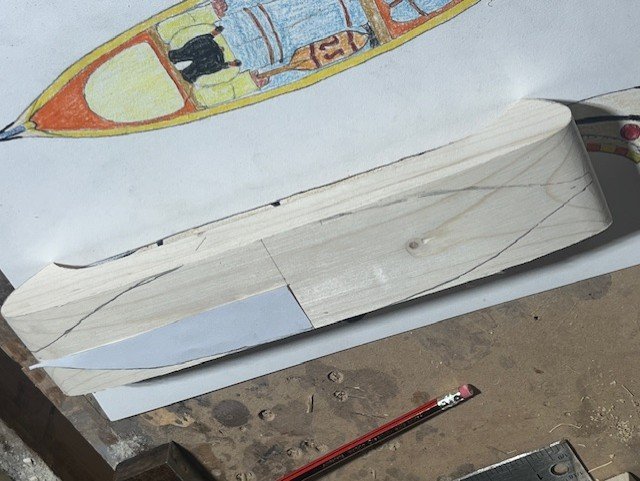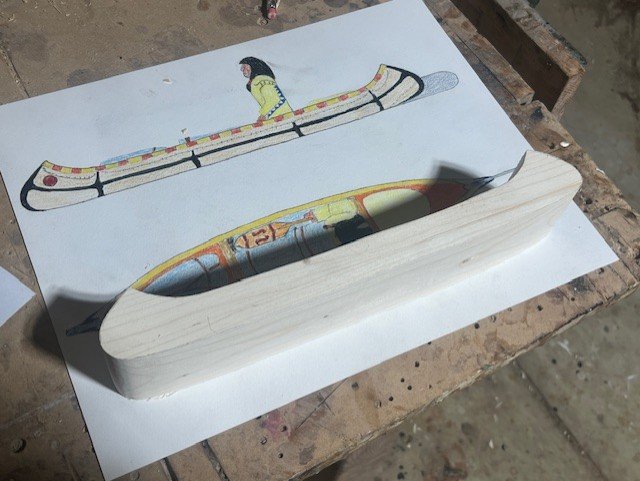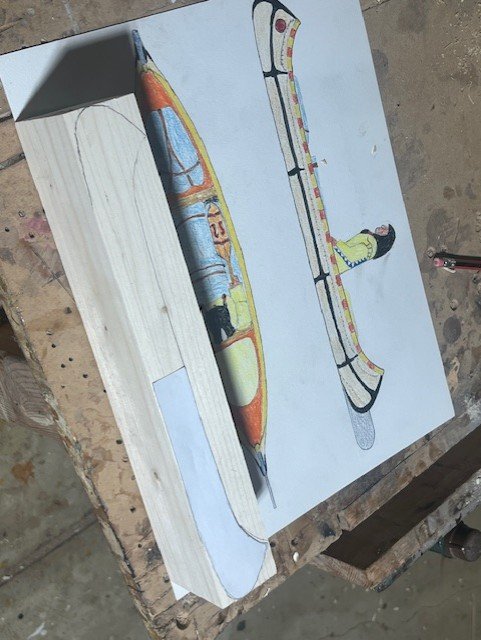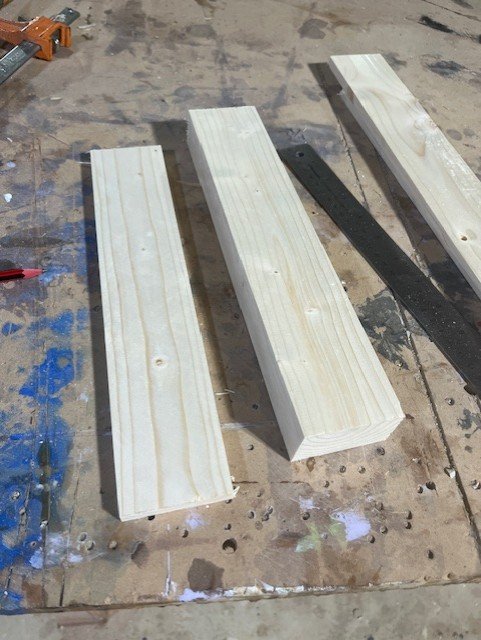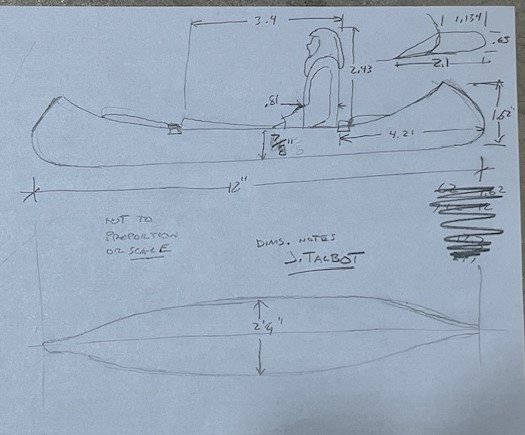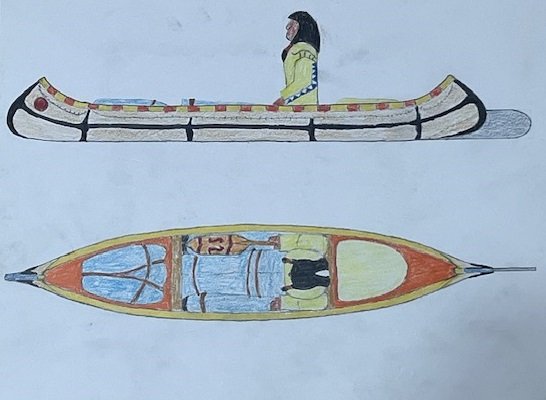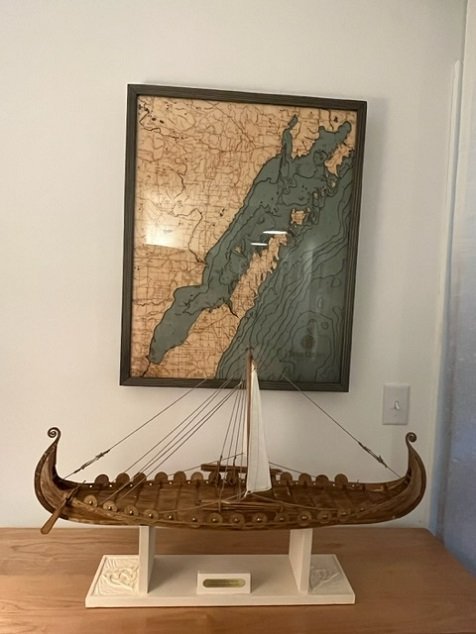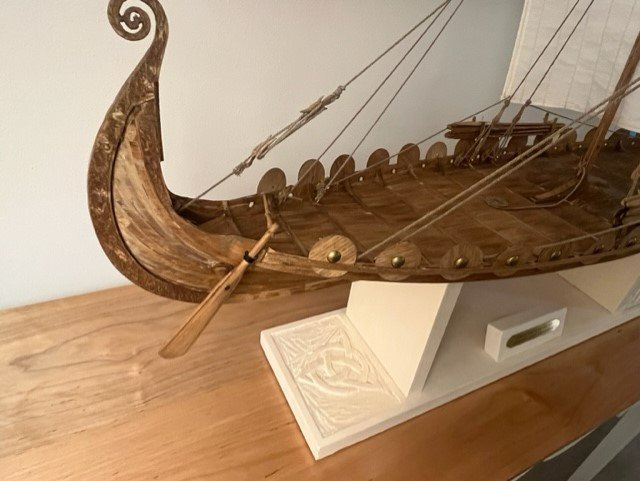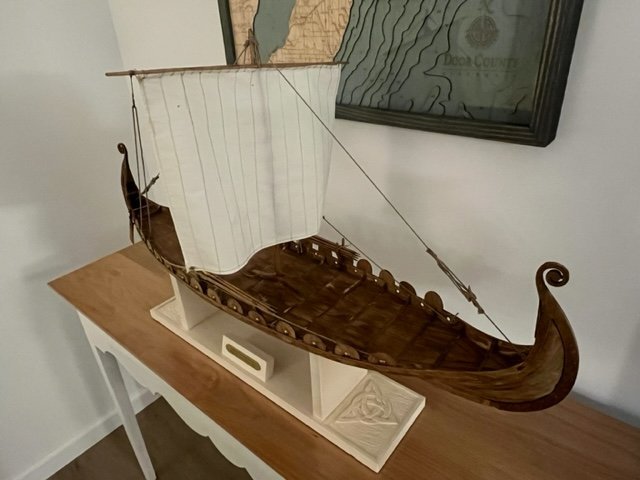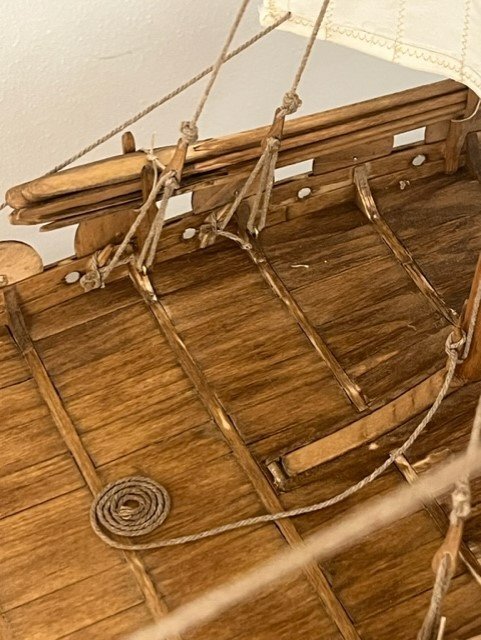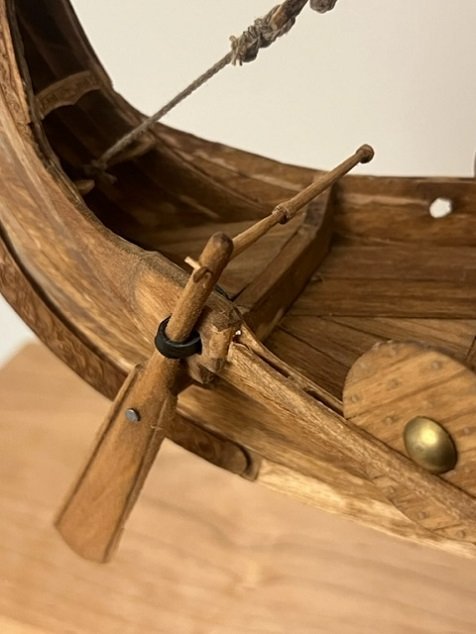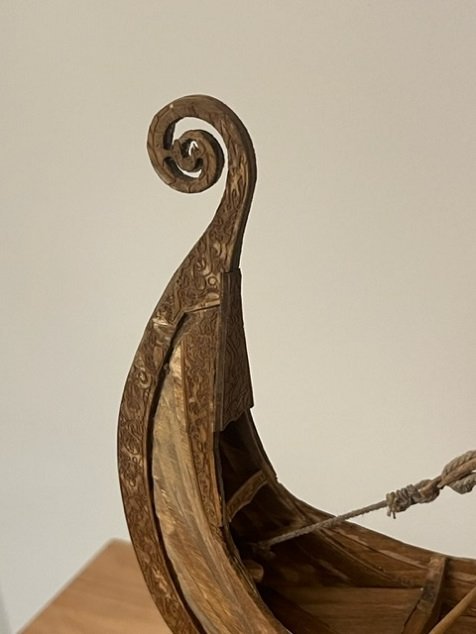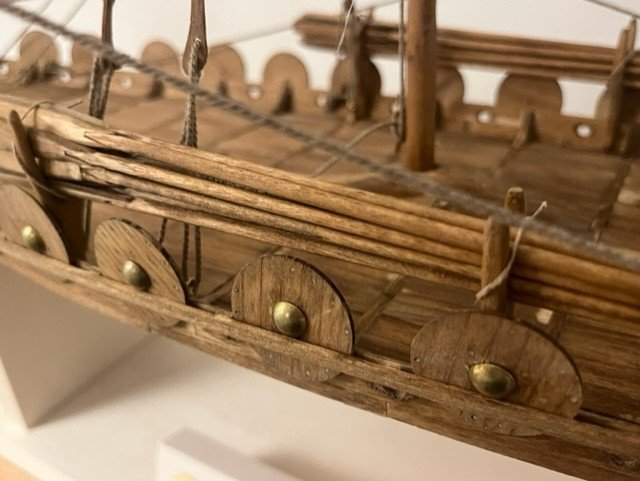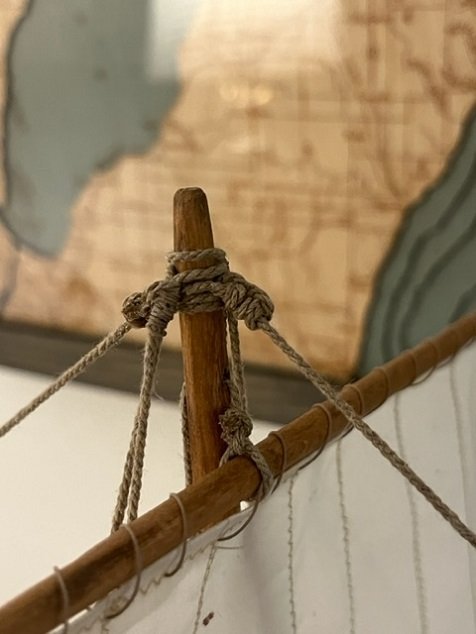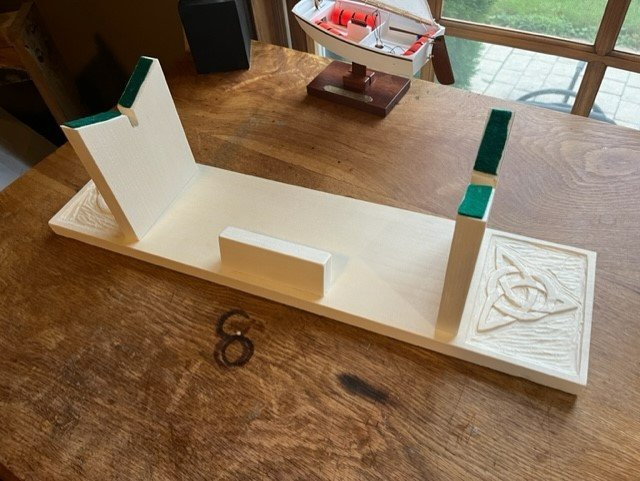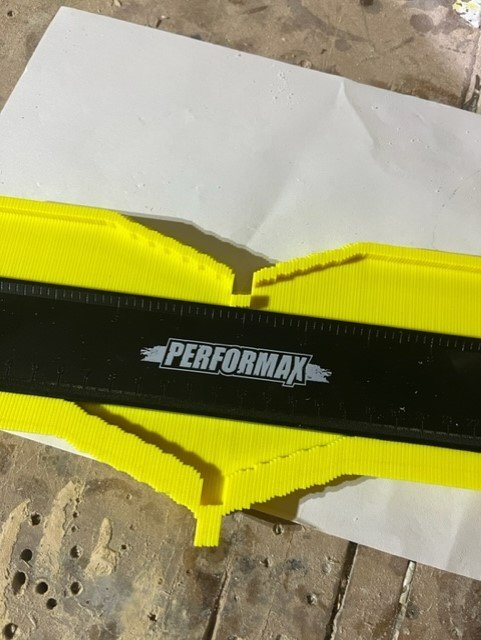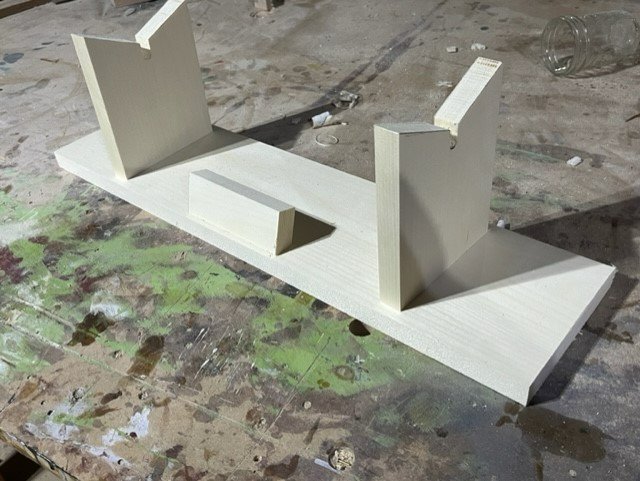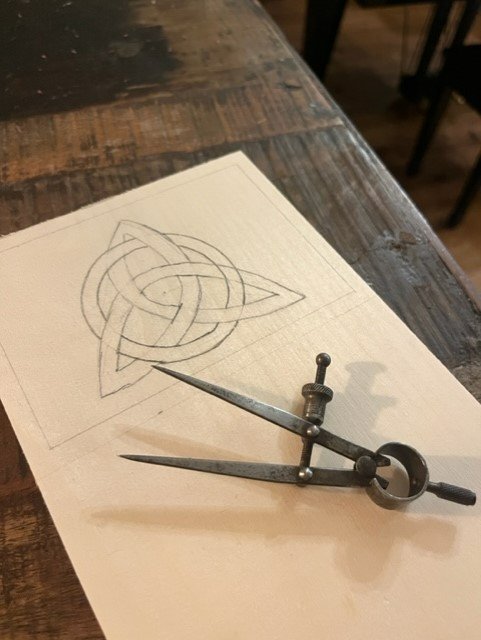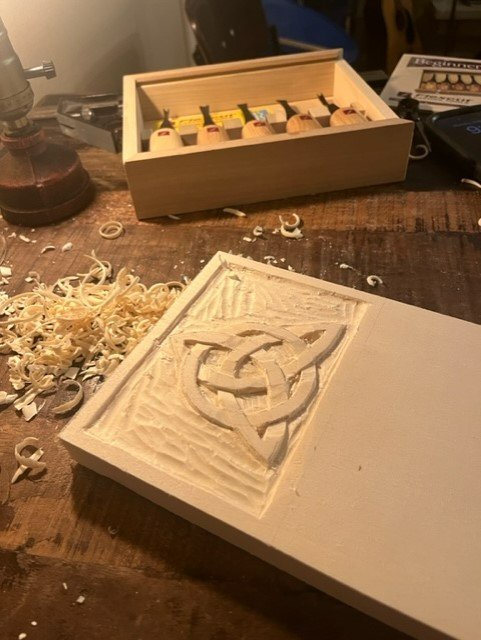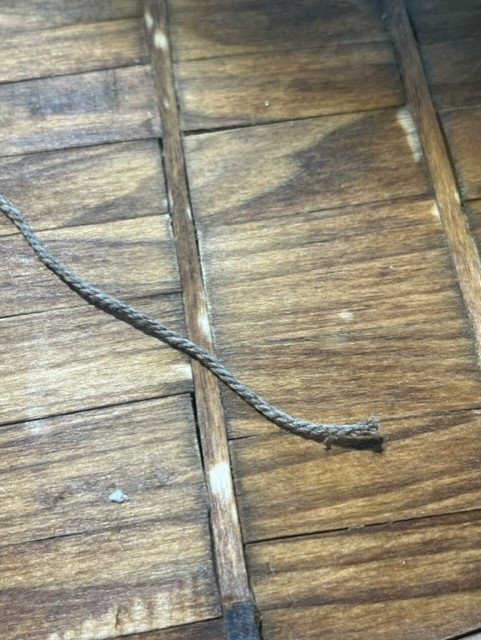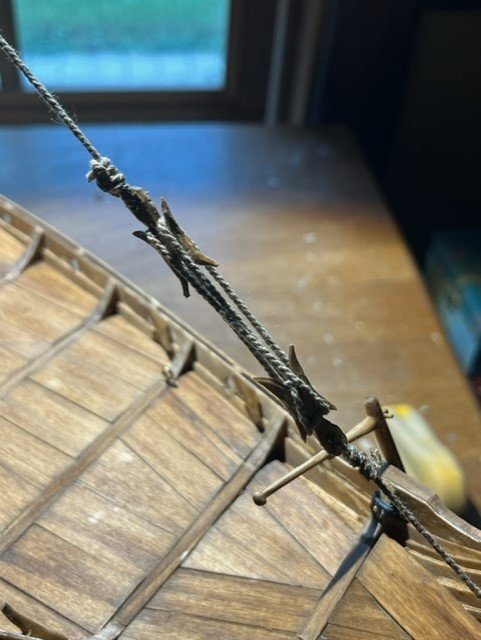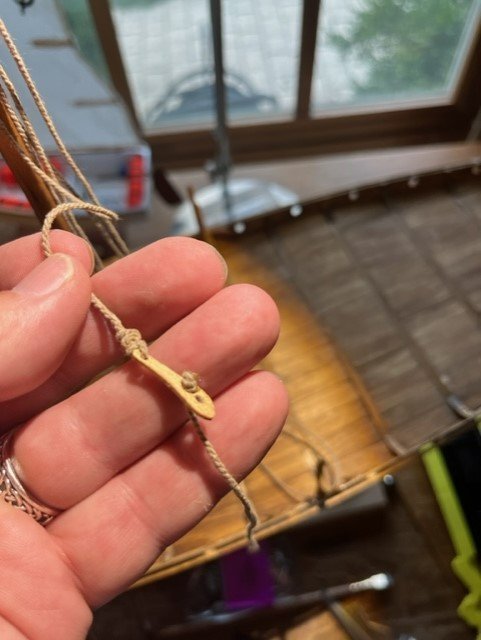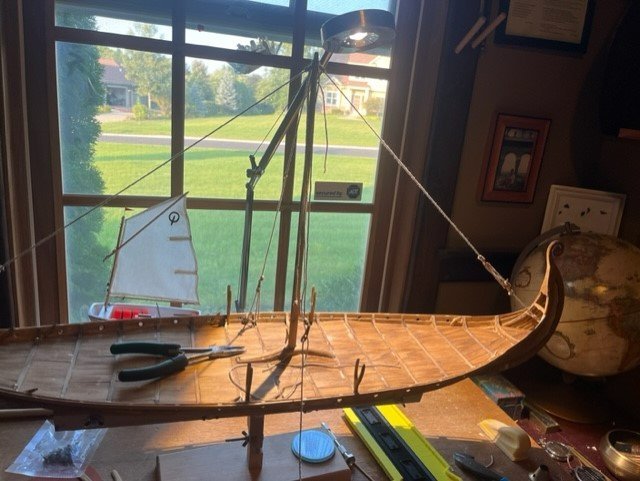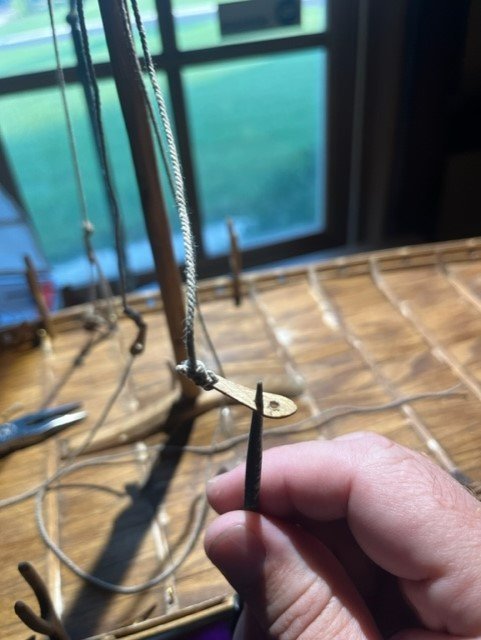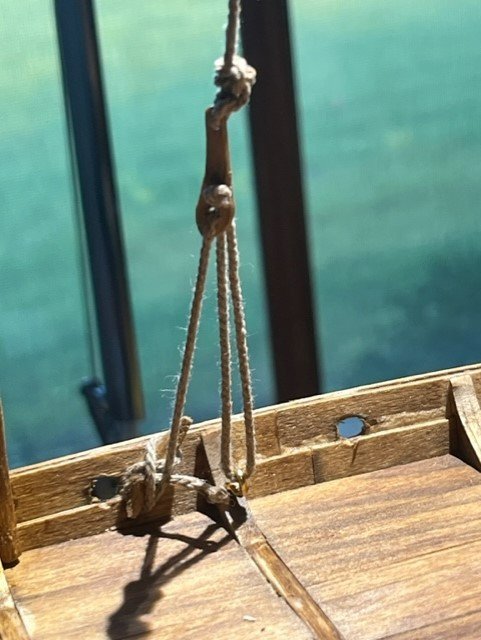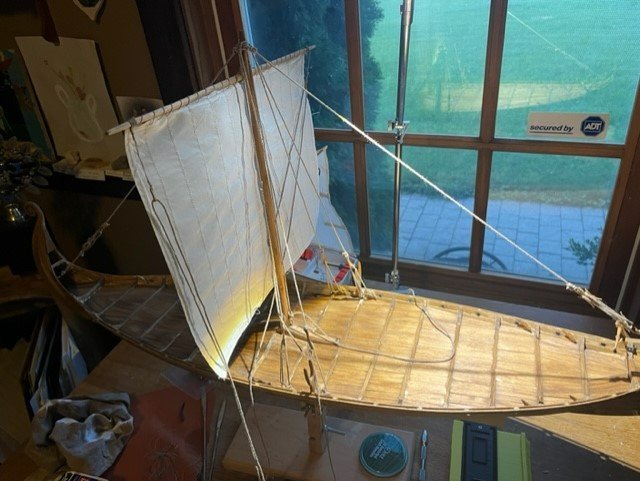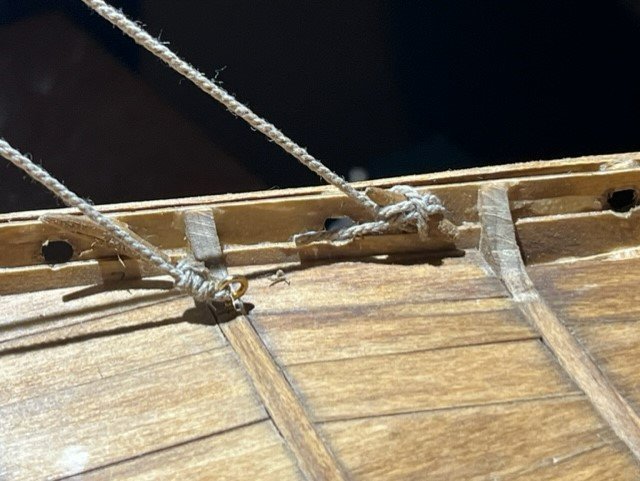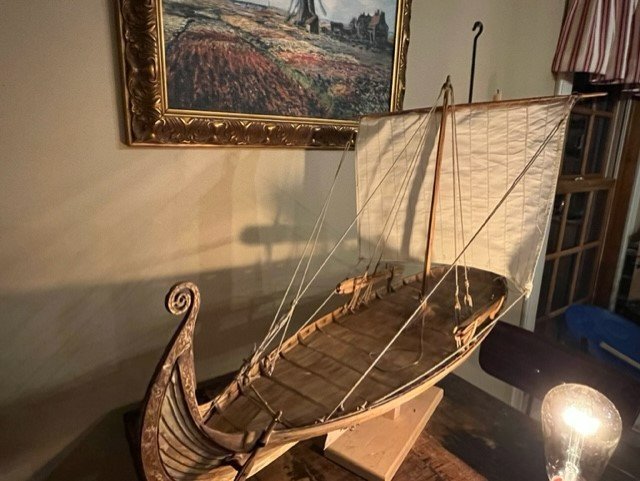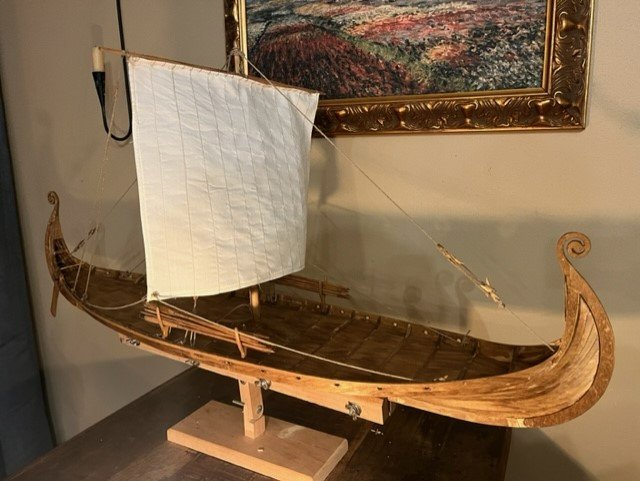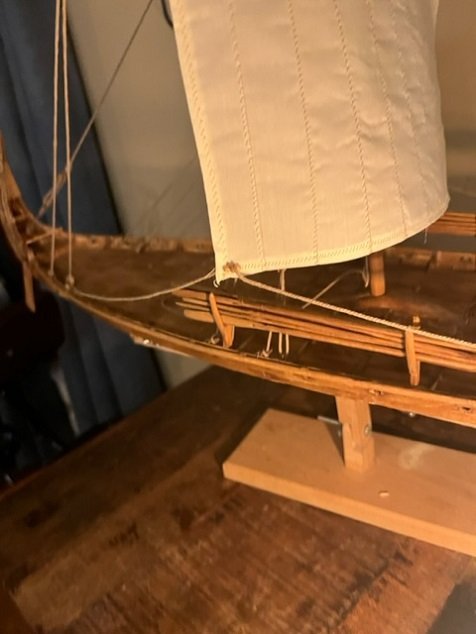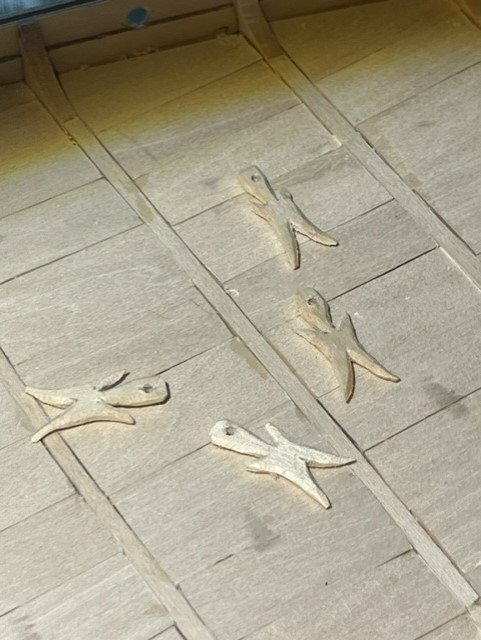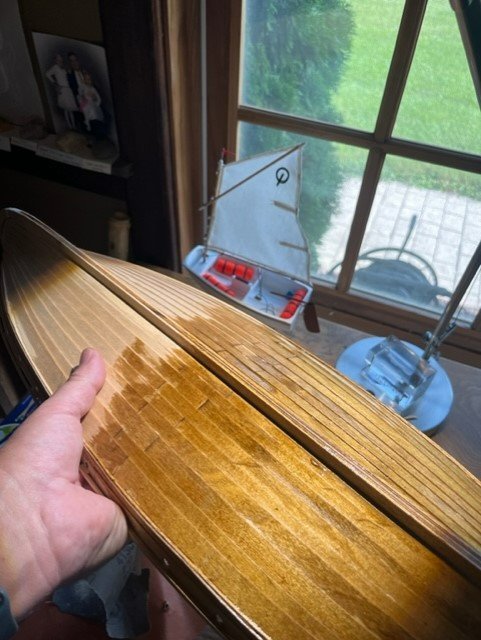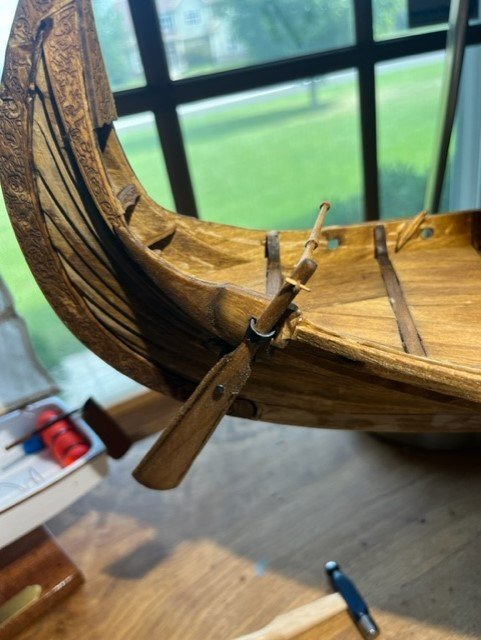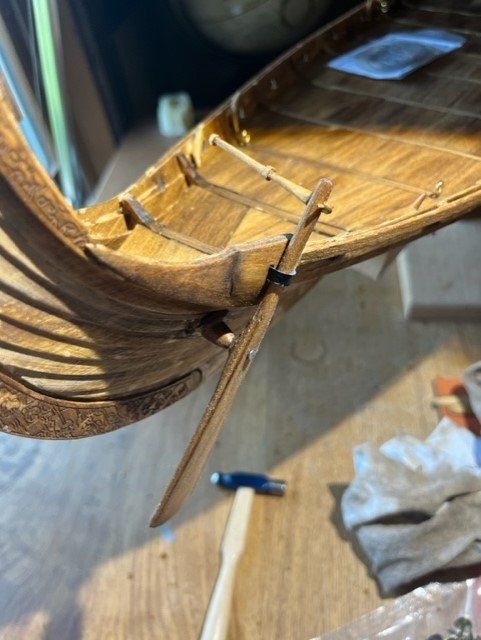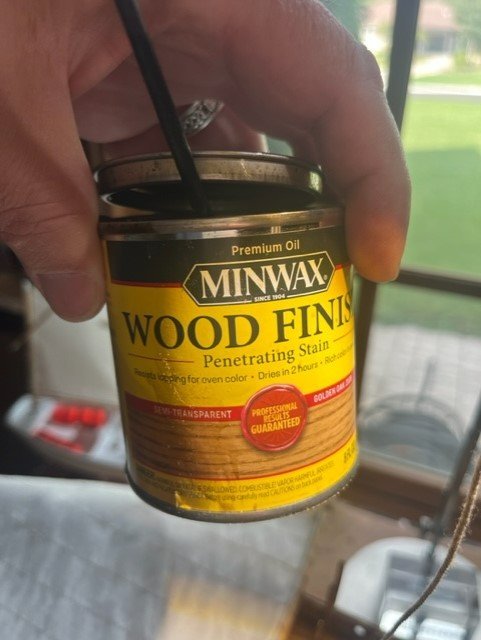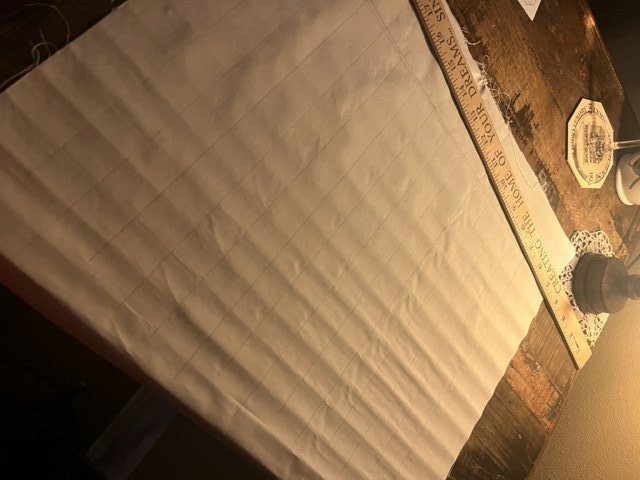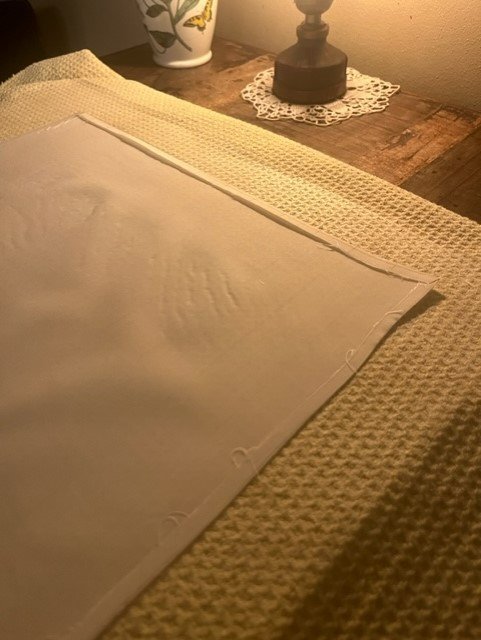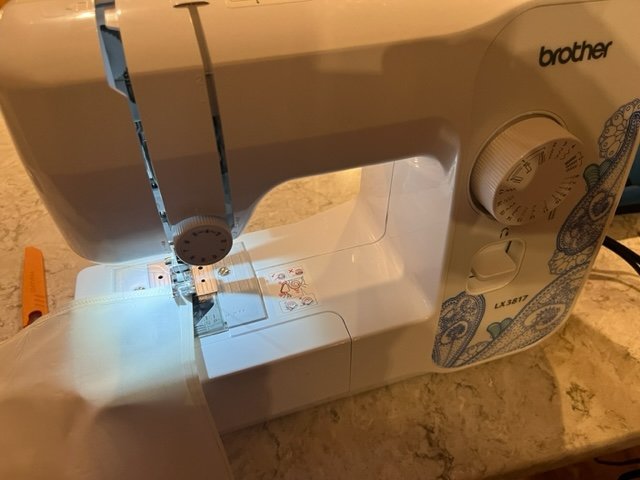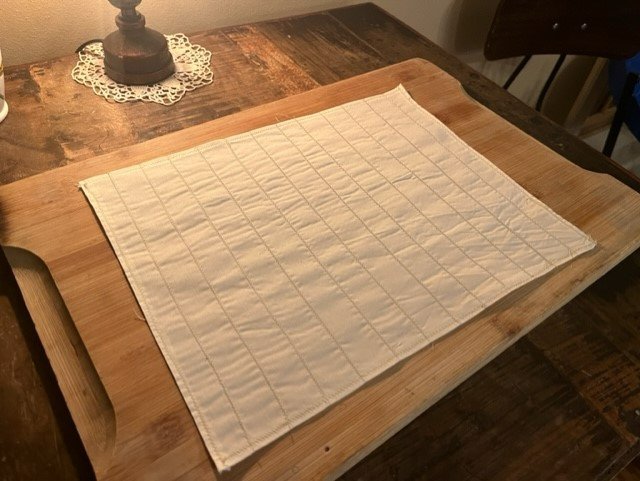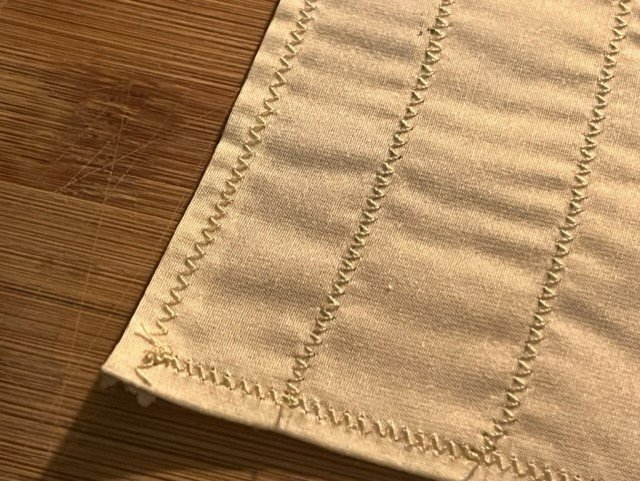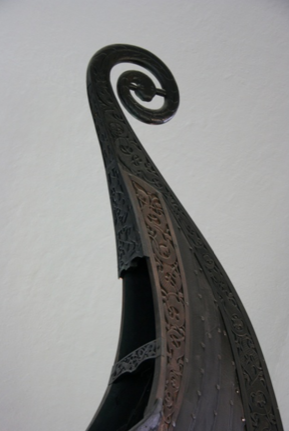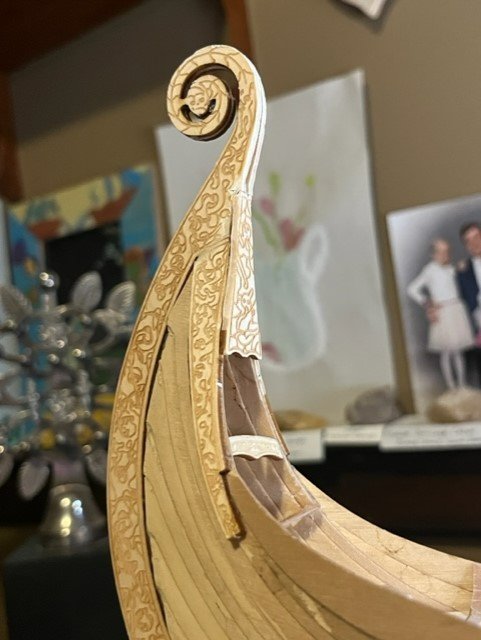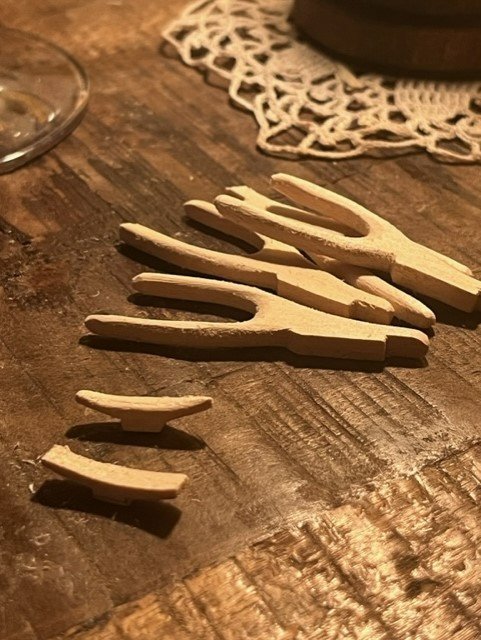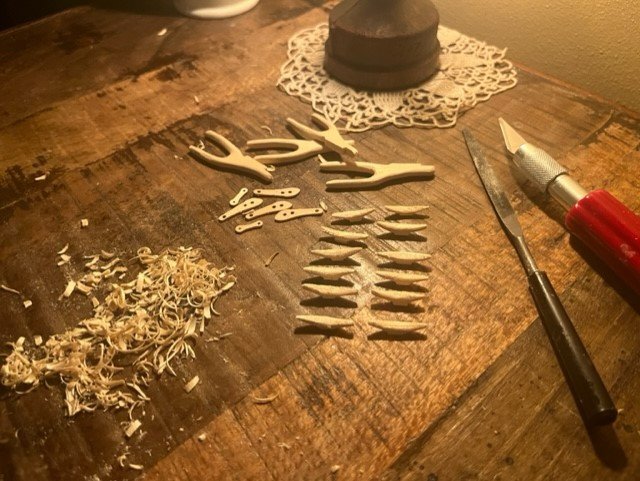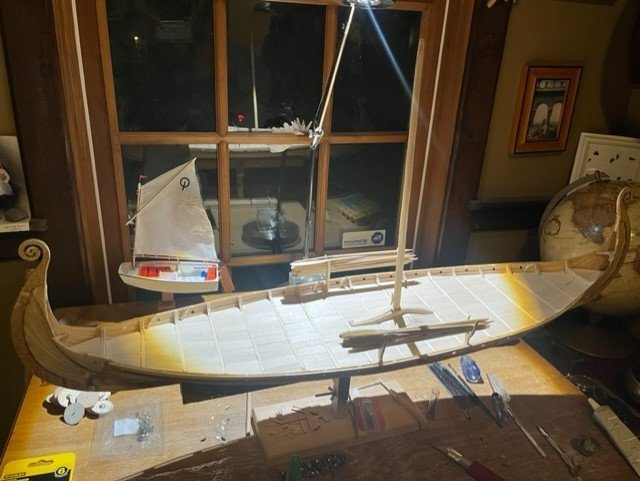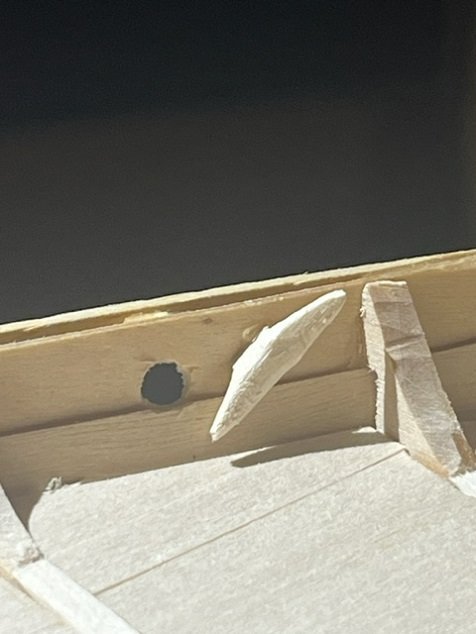-
Posts
219 -
Joined
-
Last visited
Content Type
Profiles
Forums
Gallery
Events
Everything posted by Jason Builder
-
Good Day All, I carved the mid-ships pack, the top surface of which is at an angle as shown. Then I made and glued on the hands.....he is happy to have his hands! The right hand is hollowed out to accept the paddle. I cut the rudder out of aluminum with a tin snips, and then sanded the sharp edges smooth. I cut a slot for the rudder using a thin-width blade in the hull for the rudder and then installed the rudder with super glue. And now for the final piece....the paddle! Next I wrote out the words on the bottom of the canoe and then etched them into the wood with an awl. Sanding the wood and the cast metal worked grey metal dust into the wood grain. Now time to get some paint! I will do some painting before final assembly of the parts.....in fact I wish I would not have glued in the aft pack already.
-
Notes on deviation from original design: I set out to build an accurate reconstruction of the model from the book, I think I will succeed and fail in various ways. 1. Dimensions and accuracy of shape, form and color: I believe I will be very accurate in these areas. I watched the movie clip above of the ship provided by Navyshooter, and I see three thwarts in the model used in the movie, and I fully respect that model, but I do not see three thwarts anywhere in the book, so I will stick with two. Each interpreter of a model must make their own decisions, and whoever made that model for the movie did an outstanding job in my view. 2. Materials: a. All wooden parts in the book : pine. All wooden parts in my model: Pine. b. Lead ballast in the book: Tin/Bismuth in my model....a deviation for safety purposes c. "tin" rudder in the book, I will use a piece of aluminum, a deviation for long term corrosion purposes. d. "Enamel" paints in the book, I will use same. 3. Tools: from Chapter 1 in the book , I see a hatchet and two different knives for carving the model. I used a table saw and planer to form the pine blank, and I used a bandsaw to cut out blanks for the various pieces as shown in my photos.....maybe I should have used a hand jigsaw which would have been doable. I did only use knives and chisels for carving, no dremels. 4. Construction: It is not clear from the book how the model was exactly constructed, but the impression I get from the early pages is that the boy carved it out of a single piece of pine. I made my hull from a piece of pine and am making the thwarts, packs, and man, from separate pieces which I am gluing to the model. This may be inaccurate, but! I submit the illustration from the 2nd page of chapter 26 to support my decision to make the man from a separate piece of wood with the grain vertical along the upright plane of the man. For copyright purposes I will not post the illustrations here. The illustration supports that the boy built the model with the man made from a separate piece of wood with vertical grain perpendicular to the grain of the hull. I will use wooden pegs to attach the perpendicular-grained pieces of the man and the canoe.
-
Goedenavond vrienden, Tonight was a special night because I got to light a burner, melt metal, and do my best to pour it into my model! At the point I was at in carving the hull and installing the rest of the pieces permanently, I figured I better pour the metal into the ballast slot in the bottom of the hull in case it went haywire and wrecked it. Micromark Type 280 model casting metal. tin/bismuth alloy with no lead or cadmium (I know a deviation from the lead used by the boy in the book). Melting temp 280degF. I bought two 1 7/8" pucks to melt down but only needed one. I melted the metal down in a tiny pan, which unfortunately had no spout for pouring. It worked well for melting the metal. I have a heavy pot and ladle for melting lead but did not want to contaminate this "toy" with lead. A simple camp stove was used to melt this low temp model casting metal; it melted quicker than you'd fry bacon. The "camp stove" is not the cleanest in the world as this is the stove I use to melt and make beeswax candles, not for cooking, so there is too much wax residue in the basin of the stove which I need to clean up. Back to model making....I will need to remember this handy alloy for future projects. But now, to back up a bit, before melting the metal, I levelled the hull in a vise in both directions. Then, with the metal melted, I walked as quickly as I could, the 20 feet from stove to overturned hull. In that time the hot metal formed a semi-solid skin on it's surface which I had to overcome when pouring, and which caused an overflow over the cavity intended for the pouring of the metal. This is visible in the photo. After this initial spilling of the milk, the pour went perfectly and I will be able to remove the metal from the overflow spill. All told, it would be better to use a deeper melting pot with a spout for this task. Now I will wait for this to cool and I will file and sand off the metal and all will be well. I had a fire extinguisher at my side during this step.
-
hi Chris, Great idea!! I, too, would love to see that and I have hte book here, of course, in front of me as I build the model. To all: even though this is a kids book, anyone with a inquisitive interest in industry of the great lakes in the first half of the 20th century (canal locks, sawmills and such) would love the illustrations in the margins of this book! Thank you for the note, Chris. -Jason
-
Thanks so much for the responses and for sharing your connections to the Paddle to the Sea story!! Tonight I continued some carving. I laid out and then carved the recess for the ballast. I have alot of lead left from past projects wherein I would melt lead and use it in projects. Considering the known health/brain damage risks we now know from lead exposure, I will make a variation from the originally described Paddle to the Sea. I will use low temp model casting metal from Micromark, type 208. I will melt this metal and fill this cavity. These Flexcut carving chisels are awesome!!! I am also using my Helle knife: Hull after rough carving: Another amazing tool for wordworking, is the SHINTO RASP" pictured below. Amazing, efficient, tool with two different aggressiveness faces.
-
Hi Everyone, The book states the model was made from a piece of pine, so here is my raw material, scrap 2x4 from the shop: The 2x4 is not quite thick enough, so I sawed and planed two blocks which I will glue together to make the hull blank. Here is the hull blank glued together , and cut and planed to finished length, width , height. I made some paper templates of the plan view and profile shapes of the hull. Tracing the profile here. Profile cut using the bandsaw: Tracing on the plan view shape: Here is the blank cut out on the bandsaw.....all carving from here on out:
-
Greetings! And now I return to the dreams of adventure of my youth! "Paddle to the Sea" is a childrens' book, written and illustrated by Holling Clancy Holling, and published in 1941. It tells the tale of the voyage of a small carved wooden canoe and it's paddler as they follow the currents of the Great Lakes, from Nipigon country out to the Atlantic Ocean. A Native American boy carves the canoe and it's stoic captain, paints it, and places it in the snow, high in the hills over Lake Nipigon. When the snow melts, it takes "Paddle to the Sea" with it, and the book tells the story of all the people, machines, technology, animals and natural wonders that the little canoe model sees on it's epic journey through the Great Lakes to the Atlantic. I loved the book as a boy, and I still have the book. I live in Wisconsin, not far from Lake Michigan, and the book has always been special to me. As a boy I thought how cool it would be to make this canoe and paddler model......now I have decided to do it! Below is documented my best attempt at building as close to accurate a model as possible of the actual "Paddle to the Sea" canoe model from the book. Making the drawings: There are illustrations throughout the book of Paddle to the Sea, and there are also good clues as to materials, dimensions, and finish. The book tells of the young Native American boy in Nipigon Country (North shore of Lake Superior, around Lake Nipigon), who take "many days" whittling a "piece of pine" into a "canoe one foot long". It also advises of a rudder made of tin and lead ballast. The book also advises "oil paints" were used to paint it, along the with words carved into the bottom of the hull , "Please put me back in water, I am Paddle to the Sea". Starting with the known length of 12", I scaled other dimensions from the many pictures in the book and calculated the various dimensions. Then I took those dimensions and created a life-size, to-scale, color drawing of the model, which I will use to take dimensions from as I build the model.
-
Thanks very much for the kind words all! It was a fun project!
- 75 replies
-
- Oseberg
- Billing Boats
-
(and 1 more)
Tagged with:
-
Hello Fellow Ship Modelers! I have completed the Oseberg model. This was a very fun project and I am enjoying looking at it in the location that I had in mind for it when I started building it. Some final photos below. Peace!! Jason
- 75 replies
-
- Oseberg
- Billing Boats
-
(and 1 more)
Tagged with:
-
- 75 replies
-
- Oseberg
- Billing Boats
-
(and 1 more)
Tagged with:
-
Hi Everyone! Working on the stand for the model tonight. I will make it out of Aspen, which is a bright white clear grained nordic softwood. I will be adding some celtic carving to the stand base for fun. I used a profiling gauge to draw out the angle of the bracket stands.
- 75 replies
-
- Oseberg
- Billing Boats
-
(and 1 more)
Tagged with:
-
Hi All! The rigging on this ship is quite limited and simple, making for a one-afternoon project to complete it. I used some smaller scale rope I had in stock for some lines, but mostly used the cotton rope supplied in the kit. I started rigging the ship using the very white rope in the kit but it was too bright white in my opinion so I took the whole spool of rope and dunked it in the can of stain and the pulled the rope out of the bucket through a rag to press the stain out and this resulted in a nice color rope for the ship. The holes in the standing rigging fittings needed to be enlarged in diameter, which I accomplished with a small round file. Here is the rope after staining it:
- 75 replies
-
- Oseberg
- Billing Boats
-
(and 1 more)
Tagged with:
-
Ég er næstum búinn að klára þennan bát I carved the rigging cleats for the standing rigging out of basswood. Also , I am at the point where I stained the boat! Fun step. I am going with Minwax Golden Oak stain. After staining the parts I installed the rudder, I got a longer wire nail than what was included in the kit for this purpose. All worked out nicely.
- 75 replies
-
- Oseberg
- Billing Boats
-
(and 1 more)
Tagged with:
-
Hi Everyone, Made the sail tonight. sketched out the size and the vertical seams in pencil on the fabric from the kit cut out the out line with a sharp scissors ironed the fabric, including ironing the folded over hems around the edges, to make the sewing of those edges so much easier stitched the perimeter hems and the vertical lines on the sewing machine in a zi-zag pattern Ironed the whole thing again In overall finish, I will going for a lighter stained/caramel colored woodwork and an all-white sail.
- 75 replies
-
- Oseberg
- Billing Boats
-
(and 1 more)
Tagged with:
-
Final wooden pieces to be attached to the ship....some trim pieces at the stem and stern. Note which edges of these pieces stand proud of adjacent woodwork and which are flush.
- 75 replies
-
- Oseberg
- Billing Boats
-
(and 1 more)
Tagged with:
-
Good Day All! Some work on cleats and oar racks. Rough sanding and shaping done, some finish sanding still to go (finish sanding on the whole model for that matter). Chasing down completion on a daily basis now.
- 75 replies
-
- Oseberg
- Billing Boats
-
(and 1 more)
Tagged with:
About us
Modelshipworld - Advancing Ship Modeling through Research
SSL Secured
Your security is important for us so this Website is SSL-Secured
NRG Mailing Address
Nautical Research Guild
237 South Lincoln Street
Westmont IL, 60559-1917
Model Ship World ® and the MSW logo are Registered Trademarks, and belong to the Nautical Research Guild (United States Patent and Trademark Office: No. 6,929,264 & No. 6,929,274, registered Dec. 20, 2022)
Helpful Links
About the NRG
If you enjoy building ship models that are historically accurate as well as beautiful, then The Nautical Research Guild (NRG) is just right for you.
The Guild is a non-profit educational organization whose mission is to “Advance Ship Modeling Through Research”. We provide support to our members in their efforts to raise the quality of their model ships.
The Nautical Research Guild has published our world-renowned quarterly magazine, The Nautical Research Journal, since 1955. The pages of the Journal are full of articles by accomplished ship modelers who show you how they create those exquisite details on their models, and by maritime historians who show you the correct details to build. The Journal is available in both print and digital editions. Go to the NRG web site (www.thenrg.org) to download a complimentary digital copy of the Journal. The NRG also publishes plan sets, books and compilations of back issues of the Journal and the former Ships in Scale and Model Ship Builder magazines.


